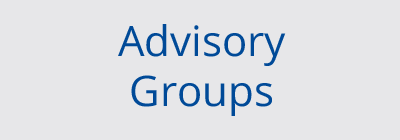
Better standards.
Better-informed decisions.
Companies, not-for-profit organizations, and governments use accounting standards as a foundation for providing users of financial statements with relevant information. That information helps investors, lenders, citizens, and others make important decisions about whether to provide capital, lend or donate money, or whether or not to support a voter referendum.
It stands to reason, then, that better accounting standards help financial statement users make better-informed decisions.
The pursuit of better standards informs everything we do. The Financial Accounting Foundation (FAF) and its standard-setting Boards—the Financial Accounting Standards Board (FASB) and the Governmental Accounting Standards Board (GASB)—are committed to fostering standards that result in information that is relevant, representationally faithful, and reflective of the financial condition of an organization or government.
What follows in these pages is a snapshot of how we fulfilled this objective in 2016. For the FASB, it meant issuing standards that give investors better information about an institution’s expected credit losses and lease obligations. For the GASB, it meant educating stakeholders about standards that enhance transparency around retirement obligations and developing an improved financial reporting model. And for the FAF, it meant supporting the Boards in these efforts while ensuring they follow a robust, inclusive due process.
Investors and citizens trust financial statements that follow Generally Accepted Accounting Principles (GAAP). Through our work, we aim to continue to earn that trust through standards that help all our stakeholders make better-informed decisions.
Major Achievements in 2016
Messages from the FAF, FASB, and GASB Leaders
Financial Review
2016 Sources of Revenues
- 53%FASB Accounting Support Fees
- 18%GASB Accounting Support Fees
- 29%Net Subscriptions & Publications
2016 Expenses
- 78%Program — Standard Setting
- 22%Support
About Us
Financial reporting is the language that communicates information about the financial condition and operational results of a company (public or private), not-for-profit organization, or state or local government. Accounting standards determine how those financial statements are prepared. The standards are known collectively as Generally Accepted Accounting Principles—or GAAP.
The Financial Accounting Foundation (FAF) is the independent, private-sector...
Advisory Groups
How We're Funded
The work of the FAF, the FASB, and the GASB is funded by a combination of accounting support fees and publications and subscriptions income.
![]()

About Us



Financial reporting is the language that communicates information about the financial condition and operational results of a company (public or private), not-for-profit organization, or state or local government. Accounting standards determine how those financial statements are prepared. The standards are known collectively as Generally Accepted Accounting Principles—or GAAP.
The Financial Accounting Foundation (FAF) is the independent, private-sector, not-for-profit organization based in Norwalk, Connecticut, responsible for the oversight, administration, financing, and appointment of the Financial Accounting Standards Board (FASB) and the Governmental Accounting Standards Board (GASB).
The FASB establishes financial accounting and reporting standards for public and private companies and not-for-profit organizations.
The GASB establishes financial accounting and reporting standards for U.S. state and local governments.
The FASB and the GASB are responsible for ensuring that GAAP remains the high-quality benchmark of financial reporting so that investors, lenders, capital providers, and other users of financial statements have access to the information they need to make better-informed decisions.
Our Mission
The collective mission of the FASB, the GASB, and the FAF is to establish and improve financial accounting and reporting standards so they provide useful information to investors and other users of financial reports and to educate stakeholders on how to most effectively understand and implement those standards.
The FASB, the GASB, the FAF Trustees, and the FAF management contribute to the collective mission according to each one’s specific role:
- The FASB and the GASB are charged with setting the highest-quality standards through a process that is robust, comprehensive, and inclusive.
- The FAF management is responsible for providing strategic counsel and services that support the work of the standard-setting Boards.
- The FAF Trustees are responsible for providing oversight and promoting an independent and effective standard-setting process.

Better standards.
Better-informed decisions.
Companies, not-for-profit organizations, and governments use accounting standards as a foundation for providing users of financial statements with relevant information. That information helps investors, lenders, citizens, and others make important decisions about whether to provide capital, lend or donate money, or whether or not to support a voter referendum.
It stands to reason, then, that better accounting standards help financial statement users make better-informed decisions.
The pursuit of better standards informs everything we do. The Financial Accounting Foundation (FAF) and its standard-setting Boards—the Financial Accounting Standards Board (FASB) and the Governmental Accounting Standards Board (GASB)—are committed to fostering standards that result in information that is relevant, representationally faithful, and reflective of the financial condition of an organization or government.
What follows in these pages is a snapshot of how we fulfilled this objective in 2016. For the FASB, it meant issuing standards that give investors better information about an institution’s expected credit losses and lease obligations. For the GASB, it meant educating stakeholders about standards that enhance transparency around retirement obligations and developing an improved financial reporting model. And for the FAF, it meant supporting the Boards in these efforts while ensuring they follow a robust, inclusive due process.
Investors and citizens trust financial statements that follow Generally Accepted Accounting Principles (GAAP). Through our work, we aim to continue to earn that trust through standards that help all our stakeholders make better-informed decisions.
Message from the FAF Chairman and FAF President and CEO
Legendary football coach Vince Lombardi once said, “the achievements of an organization are the results of the combined effort of each individual.” That’s true on many levels for the Financial Accounting Standards Board (FASB), the Governmental Accounting Standards Board (GASB), and the Financial Accounting Foundation (FAF). Together, we work toward one goal: setting the highest-quality standards through a process that is robust, comprehensive, and inclusive.
While the FASB and the GASB set the standards that constitute Generally Accepted Accounting Principles (GAAP), the FAF works to provide a solid foundation for their success. For the FAF Trustees, that means ensuring the Boards follow a thoughtful, robust, and transparent process that considers a wide range of stakeholder views. For the FAF management team, it means providing strategic counsel and support to the Boards and our Trustees.
The eighteen FAF Trustees work with the FASB and the GASB to ensure that the process of setting GAAP standards is sound, and that the Boards follow it with discipline. We took several steps in 2016 to make our work in this area even more effective.
For example, in 2012 the Trustees established the Private Company Council (PCC) to serve as the primary advisory body to the FASB on private company matters. At that time, we assigned a group of Trustees to serve on a special Private Company Review Committee (PCRC). The PCRC’s mission was to oversee and hold the FASB and PCC accountable for ensuring private company perspectives were appropriately considered in the FASB’s standard-setting process.
Our three-year review of the role and effectiveness of the PCC (conducted in 2015) concluded that the PCC was meeting its objectives, so in 2016 the Trustees took steps to transition the PCRC’s oversight role to our existing Standard-Setting Process Oversight Committee effective January 1, 2017. To maintain continuity, members of the PCRC were appointed to the Oversight Committee, whose processes were enhanced to ensure the same level of oversight and attention would be given to private company perspectives during the standard-setting process.
One of the most important responsibilities of the Trustees is to appoint the right people to serve as the stewards of GAAP—people who bring to their roles diverse perspectives, extensive professional expertise, and a clear commitment to our mission.
In 2016, we considered hundreds of candidates for seats on both standard-setting Boards, as well as the Financial Accounting Standards Advisory Council (FASAC), the Governmental Accounting Standards Advisory Council (GASAC), the PCC, and our own FAF Board of Trustees. Through nationwide searches, we identified and appointed individuals with deep professional experience in various capital market roles.
Another priority of the FAF is to communicate the importance of setting standards that provide investors, credit providers, and other financial statement users with neutral, objective information that helps them efficiently and effectively make capital allocation decisions. For this reason, our office in Washington, DC regularly interacts with elected and appointed officials, including members of Congress and regulators.
In 2016, as in prior years, the Trustees visited these stakeholders to keep them informed of our activities and to explain why the work of our Boards benefits the U.S. capital markets and citizens. These visits also gave us the opportunity to learn what’s on the minds of elected representatives in Congress—and their constituents—as well as regulators, and to respond to their questions or concerns.
Finally, we made major progress on a multi-year information technology (IT) transformation project to implement the technology tools our standard-setting Boards need to carry out their responsibilities more effectively and efficiently. As part of this technology upgrade, we launched a more collaborative, secure online platform for the FASB and the GASB to develop proposed standards and other important documents.
We also started to build a customer relationship management (CRM) platform that will help the FASB and the GASB engage more systematically with their stakeholders. It will also enable the Boards to better organize, analyze, and understand input—especially comment letters—received from stakeholders. As of this writing, the CRM platform is near completion. We expect to fully realize its benefits later in 2017.
The FAF strives to create an environment that allows the FASB and the GASB to do their best work, while ensuring that the Boards engage with a broad range of stakeholders as part of the standard-setting process. We look forward to continuing to collaborate in these areas through 2017 and beyond.
On behalf of the FAF, thank you for your interest and involvement in our work.
Sincerely,

Charles H. Noski
Chairman

Teresa S. Polley
President and CEO

FAF Board of Trustees
Officers
Charles H. Noski
Chairman
Gary H. Bruebaker
Vice Chairman
Ann Marie Petach
Secretary and Treasurer
Teresa S. Polley
President and
Chief Executive Officer
Mary P. Crotty
Chief Operating Officer
John W. Auchincloss
Vice President, General
Counsel and Assistant
Secretary
Trustee Committees
Executive
Charles H. Noski, Chairman
Gary H. Bruebaker,
Vice Chairman
Charles S. Cox
Myra R. Drucker
Nancy K. Kopp
Ann M. Spruill
Terry D. Warfield
Appointments
Ann M. Spruill, Chair
Charles M. Allen
Christine M. Cumming
Anthony J. Dowd
Myra R. Drucker
T. Eloise Foster
Kenneth B. Robinson
Diane M. Rubin
Audit and Finance
Charles S. Cox, Chair
Charles M. Allen
Gary H. Bruebaker
Susan J. Carter
Christine M. Cumming
Ann Marie Petach
Kenneth B. Robinson
Compensation
Myra R. Drucker, Chair
Gary H. Bruebaker
Susan J. Carter
Charles S. Cox
Eugene Flood, Jr.
Ann Marie Petach
Ann M. Spruill
Standard-Setting
Process Oversight
Nancy K. Kopp, Co-Chair
Terry D. Warfield, Co-Chair
Anthony J. Dowd
John C. Dugan
Eugene Flood, Jr.
T. Eloise Foster
Diane M. Rubin
John B. Veihmeyer

Right, pictured from left to right:
Anthony J. Dowd
President and Chief Executive Officer
Fairfield Maxwell, LTD.
Nancy K. Kopp
Treasurer
State of Maryland
Christine M. Cumming
Retired First Vice President and Chief Operating Officer
Federal Reserve Bank
of New York
Charles M. Allen
Retired Partner and Past Chief Executive Officer
Crowe Horwath LLP
T. Eloise Foster
Chair
Maryland Supplemental Retirement Plans
Diane M. Rubin
Retired Audit Partner and Quality Control Partner
Novogradac & Company LLP

Left, pictured from left to right:
Susan J. Carter
Board Member
BlackRock Equity/Liquidity
Mutual Fund Board,
Pacific Pension and
Investment Institute
John C. Dugan
Partner
Covington & Burling LLP
Charles H. Noski
Chairman
FAF Board of Trustees
Retired Vice Chairman
Bank of America Corporation
Terry D. Warfield
PwC Professor in Accounting and Chair, Department of Accounting and Information Systems
University of Wisconsin, Madison
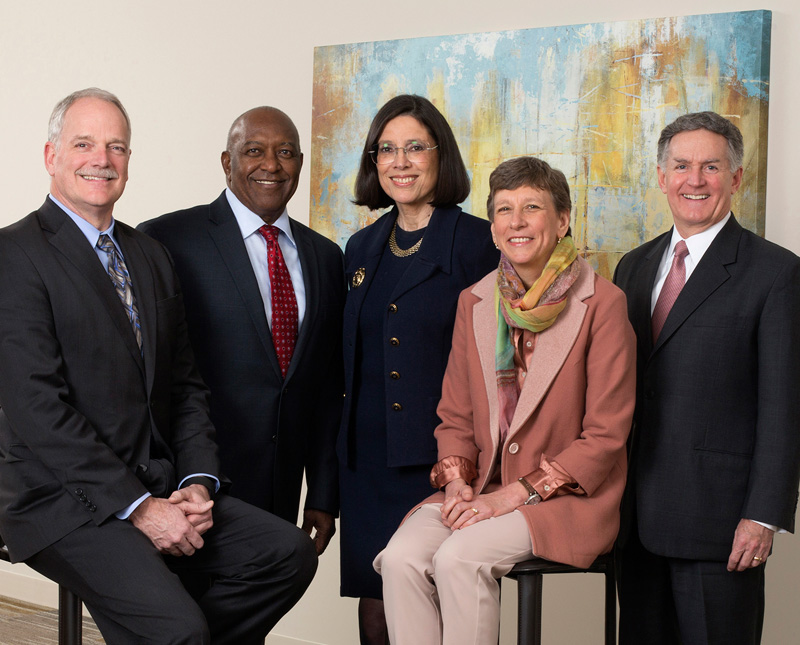
Right, pictured from left to right:
Gary H. Bruebaker
Vice Chairman
FAF Board of Trustees
Chief Investment Officer
Washington State
Investment Board
Kenneth B. Robinson
Senior Vice President
Exelon Corporation
Myra R. Drucker
Independent Director
Grantham, Mayo, Van Otterloo & Co. LLC
Ann Marie Petach
Secretary and Treasurer
FAF Board of Trustees
Board Member
BlackRock Institutional
Trust Company
John B. Veihmeyer
Chairman
KPMG International

Left, pictured from left to right:
Teresa S. Polley
President and Chief Executive Officer
Financial Accounting Foundation
Ann M. Spruill
Partner (Retired)
GMO & Co. LLC
Charles S. Cox
City Manager
City of Farmers Branch, Texas
Eugene Flood, Jr.
Board Member
Janus Capital Group Inc.
Welcome
During the past year, the FAF Board of Trustees welcomed Susan J. Carter, Anthony J. Dowd, and T. Eloise Foster.
Joined January 1, 2017
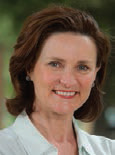
Susan J. Carter
Board Member
BlackRock Equity/Liquidity Mutual Fund Board, Pacific Pension and Investment Institute

Anthony J. Dowd
President and Chief Executive Officer
Fairfield Maxwell, LTD.

T. Eloise Foster
Chair
Maryland Supplemental Retirement Plans
Thank You
During the past year, Paul G. Camell, W. Daniel Ebersole, and Michelle R. Seitz concluded terms on the FAF Board of Trustees. On behalf of the entire organization, we thank them for their outstanding service.
Completed service on December 31, 2016
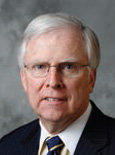
Paul G. Camell
Retired Executive Vice President and Chief Accounting Officer
CDM Smith Inc.
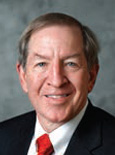
W. Daniel Ebersole
(FAF Vice Chairman)
Retired State Treasurer
State of Georgia

Michelle R. Seitz
Head of William Blair Investment Management
William Blair Investment
Messages from the
Message from the FASB Chairman
The FASB is entrusted with an important responsibility: developing accounting standards that neutrally reflect information that is relevant to investors and other financial statement users. With that responsibility comes the challenge of balancing competing interests of diverse capital market stakeholders, including investors.
In 2016, I’m pleased to report that the FASB delivered on that mission in many ways, including:
- Completing major new standards that better reflect the economics of leasing transactions and expected credit losses
- Reducing cost and complexity in the system by ensuring that preparers understand and consistently apply our standards—and that the information the standards provide is truly relevant to investors, and
- Ensuring that we serve all our stakeholders.
The leases standard we issued in February moves formerly off-balance sheet leasing activities onto the balance sheet. It addresses an area that investors told us needed to be improved, consistent with the findings of a 2005 Securities and Exchange Commission study on off-balance sheet reporting.
Issued in June, the new credit losses standard will result in more timely reporting of expected losses based on more forward-looking information—and will require enhanced transparency around the extent of those losses. The improved standard, years in development, was deeply informed by many hours of outreach with thousands of stakeholders around the world.
Other key standards issued in 2016 improved the recognition and measurement of financial instruments, financial reporting for not-for-profit organizations, and financial statements of employee benefit plans.
Our work doesn’t end when we issue a standard. In fact, that standard must come to life through robust education and training so that preparers understand it and apply it consistently. To that end, in 2016, we also focused on educating stakeholders about major standards prior to their effective dates—and simplifying other standards to reduce cost and complexity.
For example, we devoted considerable resources to monitoring the implementation of the upcoming revenue recognition standard through our Revenue Recognition Transition Resource Group (TRG). Based on feedback from the TRG, we clarified aspects of the revenue recognition guidance while making it more cost effective to implement.
We also created a Credit Losses TRG, which was informed by lessons learned from the Revenue Recognition group. Unlike its predecessor, the Credit Losses TRG met and provided feedback before the final standard was issued. This allowed us to address potential issues up front. While the FASB decided it was not necessary to create a leases TRG, our staff is closely monitoring questions that may arise around implementation of that standard.
To set effective standards, we also must make sure we’re addressing the right problems—and that means listening carefully to our stakeholders. In August, we issued an Invitation to Comment to solicit views on what we should tackle next—including potential projects on liabilities and equity, pensions, intangible assets, and financial performance reporting. Input was mixed, with some stakeholders observing that we should slow down on adding new projects until new standards have been successfully implemented. As one CPA wrote to us: “Take a vacation.”
We hear you. In 2017 our focus will be completing in-flight projects on hedging, long-term contracts issued by insurance companies, and redeliberating all aspects of our Disclosure Framework, anticipated for completion in 2018. We also will devote more resources to completing our Conceptual Framework, which will help future Board members arrive at conclusions that are more consistent so that standards are less complex. And, based on what you told us in the Invitation to Comment, the Board will vote on what its next agenda priorities should be.
We come to work every day with one big question on our minds: How can we serve all stakeholders better as we work to improve financial reporting? This is part of what I call the “cultural evolution” among all our members. It includes a shared understanding of the differences between public and nonpublic companies and not-for-profit organizations, and when those differences do—or do not—justify accounting alternatives. Our work with the Private Company Council is part of that effort.
It also drove our recent review of the efficiency of all our advisory groups. Based on that review, we refined the objectives of the Investor Advisory Committee and Small Business Advisory Committee to make their input even more meaningful. I look forward to working with these and all our advisory groups in 2017.
Thank you for continuing to share your views with the Board. Your input makes it possible for us to set standards that produce more relevant, useful information for the benefit of investors and all capital market participants.
Sincerely,

Russell G. Golden
Chairman

Members of the FASB
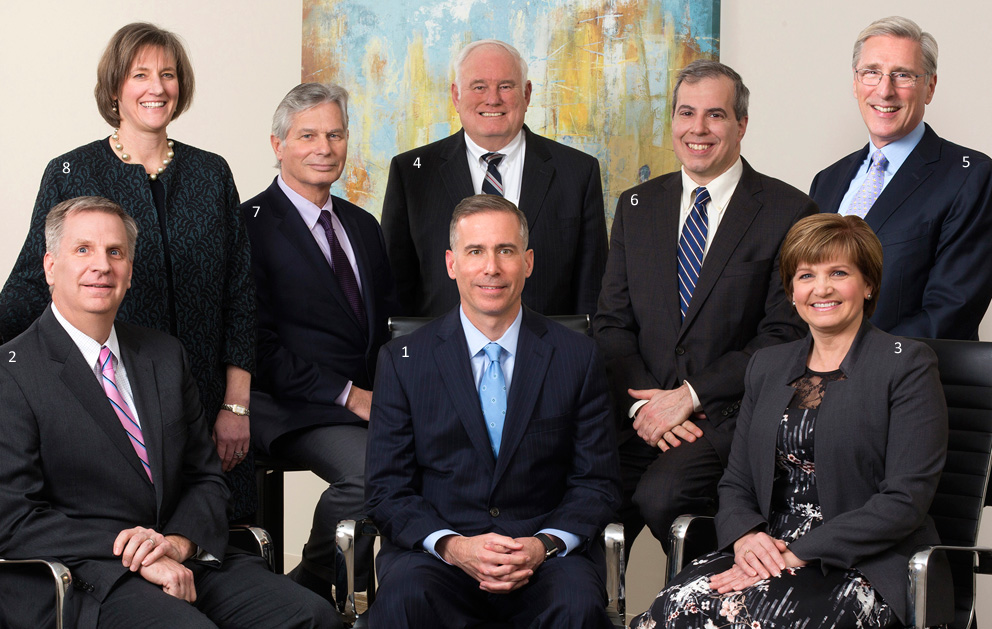
- Russell G. Golden
Chairman - James L. Kroeker
Vice Chairman - Christine Ann Botosan
Board Member - Harold L. Monk, Jr.
Board Member
- R. Harold Schroeder
Board Member - Marc A. Siegel
Board Member - Lawrence W. Smith
Board Member - Susan M. Cosper
Technical Director
2016 FASB Highlights
- Recognition and Measurement of Financial Assets and Financial Liabilities
- Leases
- Improvements to Employee Share-Based Payment Accounting
- Measurement of Credit Losses on Financial Instruments
- Presentation of Financial Statements of Not-for-Profit Entities
- Consolidation: Interests Held through Related Parties That Are under Common Control
- Narrow-Scope Improvements to Revenue Recognition Guidance:
- Principal versus Agent Considerations (Reporting Revenue Gross versus Net)
- Identifying Performance Obligations and Licensing
- Narrow-Scope Improvements and Practical Expedients
- Technical Corrections and Improvements
- Emerging Issues Task Force Consensuses:
- Liabilities—Extinguishments of Liabilities: Recognition of Breakage for Certain Prepaid Stored-Value Products
- Derivatives and Hedging: Effect of Derivative Contract Novations on Existing Hedge Accounting Relationships
- Derivatives and Hedging: Contingent Put and Call Options in Debt Instruments
- Statement of Cash Flows: Classification of Certain Cash Receipts and Cash Payments
- Statement of Cash Flows: Restricted Cash
- Private Company Council Consensus:
- Intangibles—Goodwill and Other, Business Combinations, Consolidation, Derivatives and Hedging: Effective Date and Transition Guidance
- Simplification:
- Simplifying the Transition to the Equity Method of Accounting
- Income Taxes: Intra-Entity Transfers of Assets Other Than Inventory
Welcome
During the past year, the FASB welcomed Christine Ann Botosan and Harold L. Monk, Jr.
Joined July 1, 2016
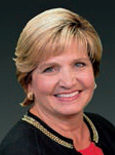
Christine Ann Botosan
Prior to joining the FASB, Ms. Botosan served as a professor of accounting at the David Eccles School of Business at the University of Utah.
Joined January 1, 2017
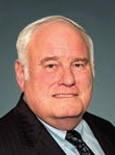
Harold L. Monk, Jr.
Prior to joining the FASB, Mr. Monk served as a partner with Carr, Riggs & Ingram, LLC.
Thank You
Last year, Thomas J. Linsmeier and Daryl E. Buck concluded terms on the FASB. On behalf of the entire organization, we thank them for their outstanding service.

Thomas J. Linsmeier
Served on the FASB
from July 1, 2006
to June 30, 2016.

Daryl E. Buck
Served on the FASB
from February 28, 2011
to December 31, 2016.
Messages from the
Message from the GASB Chairman
The work we do at the GASB leads to information that you can understand, trust, and put to work. By put to work, I mean that financial statements prepared using our standards can provide key information that will help you answer many foundational questions.
Questions like:
- Should I invest in this bond?
- Is this community right for our family?
- Is this school district on solid financial ground?
While financial reporting may not provide all the information needed to answer these questions—and, in some cases, may be just one of several resources that will be used—it does provide valuable information that places the reader in a position to be able to make better-informed decisions.
The GASB made significant progress in 2016 on improving accounting and financial reporting standards for the more than 90,000 state and local governments in the United States. We also focused on educating stakeholders about the impact of our work.
Postemployment Benefits
We continued our stakeholder outreach and education on pensions and other postemployment benefits (OPEB), which includes retiree healthcare.
Together, these standards are meant to provide a clear, consistent, and comprehensive picture of what governments have promised—and how much it will cost taxpayers and other resource providers to honor those promises.
To help put it in perspective, more than 14 million of the 120+ million full-time employees in the United States work in state and local government. These numbers don’t reflect the millions more who have retired from careers in government.
In 2015, governments paid more than $132 billion into the pension plans that hold $3.8 trillion in assets for these workers. These plans generated nearly $169 billion in investment income in 2015 with those assets, and they paid out $266 billion in benefits over the year. When the numbers have this many digits and the stakes are the futures of millions of current and retired workers, it’s important that everyone has access to the right information.
Our work helps investors, citizens, and others gain greater insight into governments’ pension and OPEB promises. But it also helps governments track whether the promises they’ve made are in-line with money they’ve set aside to honor them—or if adjustments may be needed.
These standards mean significant changes for how governments prepare financial statements, how auditors attest to those statements, and how investors, residents, and others analyze them. We know it’s a lot to digest so we’re doing several things to help stakeholders prepare.
Last year, this included:
- Offering 100+ presentations across the country
- Having staff available to answer questions by telephone
- Hosting and participating in webinars
- Conducting media and stakeholder outreach, and
- Developing guides to provide answers to key implementation questions.
Because the OPEB standards will become effective for OPEB plans this summer and for government employers next year, we’ll continue these kinds of efforts to help promote as smooth a transition as possible to reporting under the new requirements.
The Blueprint
We’re also taking a fresh look at the fundamental blueprint for financial reports—the financial reporting model. After two years of research, input from hundreds of financial statement users, preparers, and auditors, and more than a year of work at the Board table, the GASB issued a document for comment just before year-end.
Ultimately, we want to make sure the right information is presented in the financial reports—and that it’s being presented in the best way for the people who rely on it.
This project is the first of three related efforts that will let the GASB take a comprehensive look at financial reporting over the coming years—and to make targeted improvements. The next project addresses revenue and expense recognition to make those standards adapt to an ever-changing environment. Finally, the GASB staff currently is undertaking a comprehensive research effort to assess the effectiveness of note disclosures.
We’ve staggered the timing of “The Big Three” to allow us to work on them in unison and issue them consecutively—so the information is available as quickly as possible.
Final Thoughts
In 2017, the GASB is continuing to build on the progress we’ve made to make sure stakeholders have the information they need. If you have ideas about how the Board can do that better, I’d be eager to hear from you.
Stakeholder feedback drives our work. In 2016, in one way or another, thousands of you reached out to share your views. That’s very gratifying and we appreciate your engagement.
To everyone who took the time to share ideas with us in 2016, I extend the GASB’s sincere thanks—and encourage you to continue to collaborate with us over the coming year. For those who have not taken this opportunity in the past, now is the perfect time to have your voice be heard.
Sincerely,

David A. Vaudt
Chairman

Members of the GASB
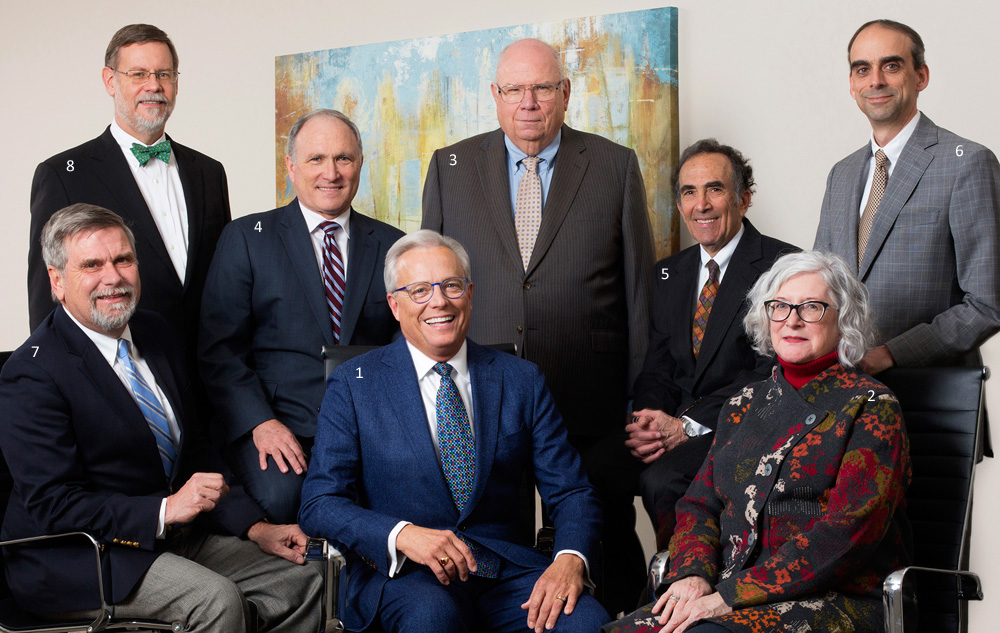
- David A. Vaudt
Chairman - Jan I. Sylvis
Vice Chairman - James E. Brown
Board Member - Brian W. Caputo
Board Member
- Michael H. Granof
Board Member - Jeffrey J. Previdi
Board Member - David E. Sundstrom
Board Member - David R. Bean
Director of Research and Technical Activities
2016 GASB Highlights
Final Statements
- Certain Asset Retirement Obligations
- Pension Issues
- Irrevocable Split-Interest Agreements
- Blending Requirements for Certain Component Units
- Implementation Guidance Update—2016
Proposals
- Exposure Drafts
- Omnibus
- Certain Debt Extinguishment Issues
- Leases
- Invitation to Comment
- Financial Reporting Model Improvements— Governmental Funds
- Exposure Draft, Implementation Guides
- Implementation Guidance Update
- Financial Reporting for Postemployment Benefit Plans Other Than Pension Plans
Welcome
Last year, the GASB welcomed Jeffrey J. Previdi to the Board.
Joined July 1, 2016

Jeffrey J. Previdi
Prior to joining the GASB, Mr. Previdi served in a variety of roles for more than two decades at Standard & Poor’s Ratings Services.
Thank You
Last year, William W. Fish concluded his term on the GASB. On behalf of the organization, we thank him for his outstanding service.

William W. Fish
Served on the GASB
from February 1, 2012
to June 30, 2016.
Messages from the

Better Standards: Credit Losses
Banks and other lenders are in the business of taking measured credit risk. With this risk comes some expectation that not every loan will be repaid.
Traditionally, Generally Accepted Accounting Principles (GAAP) has required an “incurred loss” accounting model for recognizing such losses, meaning that the loss from a specific loan isn’t recognized until it is probable a loss has been incurred. This model has been criticized for unduly delaying the recognition of reserves in an economic downturn.
The global financial crisis of 2007–2008 underscored this criticism.
During the run-up to the financial crisis, financial statement users recognized the rising credit risk. So, well before accounting rules permitted the recognition of those losses, investors began to compensate for known shortcomings in GAAP by making their own estimates of expected credit losses using forward-looking information and devaluing financial institutions. This common practice highlighted the fact that the information needs of users were not satisfied by GAAP.
Similarly, preparers expressed frustration during this period because they could not record credit losses that they were expecting simply because an accounting threshold of “probable” had not been met.
On June 16, 2016, the FASB issued a standard that will require more timely recording of credit losses on loans and other financial instruments held by all entities including financial institutions.
The new standard aligns the accounting with the economics associated with changes in credit risk by requiring lenders to immediately record the full amount of expected credit losses as loans are originated, thereby providing investors with management’s expectations of losses on a more timely basis.
The new standard will require management’s expectation of credit losses for financial assets to be based on historical experience and current conditions, as well as reasonable and supportable forecasts. It requires financial institutions to use forward-looking information to better inform their credit loss estimates, thus aligning the different stakeholders on the same path.
On June 16, 2016, the FASB issued a standard that will require more timely recording of credit losses on loans and other financial instruments held by all entities including financial institutions.
FASB Outreach on the credit losses standard
Meetings with
more than
200
users of
financial statements
![]()
![]()
More than
85
meetings and
workshops with
preparers
10+
roundtables with more
than 100 representatives
including users, preparers,
regulators, and auditors
![]()
![]()
25
fieldwork meetings with
preparers from industries
including banking
institutions of various sizes,
nonfinancial organizations,
and insurance companies

Better Standards: Leases
Leasing is integral to the modern economy. Each year, trillions of dollars’ worth of airplanes, buildings, cars, construction equipment, and other assets are leased for many obvious reasons: leasing is a means of gaining access to assets while reducing an organization’s exposure to the risks of full ownership.
However, investors and others have criticized the current operating lease accounting model for sometimes failing to provide them with a faithful representation of leasing transactions. The U.S. Securities and Exchange Commission echoed these concerns in a 2005 staff report on off-balance sheet activities that recommended changes to the existing lease accounting requirements.
To address these concerns, in February 2016, the FASB issued a new standard intended to improve transparency around lease obligations. The standard will require organizations that lease assets—referred to as “lessees”—to recognize on the balance sheet the assets and liabilities for the rights and obligations created by those leases.
Under the new guidance, a lessee will be required to recognize assets and liabilities for all leases with lease terms of more than 12 months. Consistent with current Generally Accepted Accounting Principles (GAAP), the recognition, measurement, and presentation of expenses and cash flows arising from a lease by a lessee primarily will depend on its classification as a finance or operating lease.
However, unlike current GAAP—which requires only capital leases to be recognized on the balance sheet—the new standard will require both types of leases to be recognized on the balance sheet.
The standard also will require enhanced disclosures to help investors and other financial statement users better understand the amount, timing, and uncertainty of cash flows arising from leases.
The standard will require organizations that lease assets—referred to as “lessees”—to recognize on the balance sheet the assets and liabilities for the rights and obligations created by those leases.
FASB Outreach on the leases standard
More than
200
meetings with
preparers and users
(which included
private companies
and not-for-profit
organizations)
![]()
15
public roundtables,
with more than
180
representatives and
organizations, and
2
roundtables that were
focused specifically
on private companies
and not-for-profits
15
preparer workshops
attended by
representatives
from more than
90
organizations
![]()
![]()
14
fieldwork
meetings
with preparers
Both the FASB and the
International Accounting
Standards Board (IASB)
met with more than
500
users of financial
statements
![]()

Better Standards: Postemployment Benefits
The GASB’s new generation of standards for pensions and retiree health care benefits are designed to provide a more complete picture of the benefits governments have promised to provide—including clear information on how much they cost.
The standards now feature an independent accounting approach—and separate how governments account for these benefits from how they fund them.
Fundamental changes like these introduce new information—that means stakeholders are going to have questions and need support as they transition to the new requirements. To help preparers, auditors, and financial statement users during the transition, we’re focused on answering the questions they have and providing the educational opportunities they need.
In 2016, we engaged with stakeholders in all 50 states—in person, on the telephone, and by webcast. Our outreach included more than 100 targeted, specifically tailored presentations to all types of stakeholder groups ranging in size from a few dozen to several thousand. In these sessions, we walked stakeholders step-by-step through how the new requirements work—and answered their questions as they arose.
Through our technical inquiry hotline, we answered more than 500 specific real-life questions on pensions and other postemployment benefits (OPEB). Some of these wrapped up in only ten minutes while others required many hours with several follow-up calls.
As we meet with stakeholders to talk about their issues, it often becomes clear that certain questions should be addressed more broadly. GASB Implementation Guides provide answers to just these kinds of broad-application questions. We’ve already issued guides on common pensions questions and are finalizing guides on OPEB this year.
The GASB works hard to make sure stakeholders have the information they need to put our standards to work. If you have questions or need clarification on postemployment benefit issues—or any other area of governmental accounting—we’d be very pleased to hear from you.
The standards now feature an independent accounting approach—and separate how governments account for these benefits from how they fund them.
GASB Outreach on the postemployment benefits standards
Outreach
to all
50
states
![]()
![]()
More than
100
stakeholder
presentations
across the country
Answered
more than
500
case-specific
stakeholder
questions
![]()
![]()
Provided
Implementation
Guides with
Q&As
addressing
many key issues

Better Standards: Financial Reporting Model
The financial reporting model is the fundamental blueprint for governmental financial reports. Because GASB research indicates that the model is working as intended for the most part, our work doesn’t start with a clean sheet of paper. Instead, we’re focusing on targeted areas of improvement.
The GASB began this effort by conducting extensive outreach with stakeholders. We held 10 roundtable discussions across the country to get a handle on what stakeholders believed was working with the model and what issues needed further consideration. As it turns out, the 144 of you who took part had a lot to say. While we did gain the rich variety of perspectives that we were hoping for, one message came through loud and clear: don’t throw the baby out with the bath water.
Your input informed the crafting of surveys, which brought us expanded feedback from hundreds more stakeholders—including 265 financial statement preparers, 164 auditors, and 184 users.
What the GASB learned from the survey results set the stage for nearly 150 deeper-dive interviews with a cross section of stakeholders that provided additional texture—and more specifics into what kind of targeted improvements they believed would improve the model.
With all this input as our guide, the Board formally added the project to the agenda in September 2015. Then, after more than a year of discussion at the Board table, we ultimately issued a draft document, and we asked for still more feedback from you.
In the past few months, more than 100 of you or organizations that represent you shared your views with us in writing—and several dozen more offered perspectives during a series of public hearings and user forums that we held across the country.
This degree of stakeholder involvement is the foundation of high-quality standard setting. Your feedback and ideas will be critical factors in shaping the future of this project and will influence the path that the Board chooses to improving the financial reporting model.
Because GASB research indicates that the model is working as intended for the most part, our work doesn’t start with a clean sheet of paper. Instead, we’re focusing on targeted areas of improvement.
GASB Outreach on the financial reporting model
10
roundtables with
144
participants
![]()
Research included
hundreds of survey
participants:
Preparers:
265
Auditors:
164
Users:
184
Almost
150
deeper-dive
interviews
![]()
![]()
More than
100
comment letters
to the Invitation
to Comment
Five public hearings
and three user forums
held in spring 2017
with almost
100
participants
![]()
Advisory Groups
Advisory and other groups provide critical input to the FASB and the GASB. Complete membership rosters for each group are available by clicking on the group's icon below.
FASB ADVISORY GROUPS
Financial Accounting Standards Advisory Council
Advises the FASB on issues related to projects on the Board’s agenda, possible new agenda items, project priorities, procedural matters that may require the attention of the FASB, and other matters as requested by the chairman of the FASB. FASAC meetings provide the Board with an opportunity to obtain and discuss the views of a very diverse group of individuals from varied business and professional backgrounds.
Investor Advisory Committee
Provides advice, from the investors’ perspective, on current and potential FASB agenda projects.
Not-for-Profit Advisory Committee
Provides advice on existing guidance, current and proposed technical agenda projects, and longer-term issues related to the not-for-profit sector.
Small Business Advisory Committee
Provides advice on FASB projects related to the operationality and the anticipated costs, complexities, and benefits of potential solutions principally from a small public company perspective.
OTHER KEY FASB GROUPS
Emerging Issues Task Force
The mission of the EITF is to assist the FASB in improving financial reporting through the timely identification, discussion, and resolution of financial accounting issues within the framework of the FASB Accounting Standards Codification®.
Private Company Council
The PCC is the primary advisory body to the FASB on private company matters. The PCC uses the Private Company Decision-Making Framework to advise the FASB on the appropriate accounting treatment for private companies for items under active consideration on the FASB’s technical agenda. The PCC also advises the FASB on possible alternatives within GAAP to address the needs of users of private company financial statements. Any proposed changes to GAAP are subject to endorsement by the FASB.
GASB ADVISORY GROUP
Governmental Accounting Standards Advisory Council
Consults with the GASB on technical issues on the Board’s agenda, project priorities, matters likely to require the attention of the GASB, selection and organization of task forces, and such other matters as may be requested by the GASB or its chairman. GASAC meetings provide the Board with an opportunity to obtain and discuss views with a broad representation of preparers, attestors, and users of financial information.
Financial Accounting Standards Advisory Council
![]()
Advises the FASB on issues related to projects on the Board’s agenda, possible new agenda items, project priorities, procedural matters that may require the attention of the FASB, and other matters as requested by the chairman of the FASB. FASAC meetings provide the Board with an opportunity to obtain and discuss the views of a very diverse group of individuals from varied business and professional backgrounds.
FASAC Chair
Andrew G. McMaster, Jr.
FASAC Executive Director
Alicia A. Posta
Members
Kimber Bascom
Partner
KPMG LLP
Stuart Birdt
Investment Officer
Interlaken Management, LLC
R. Scott Blackley
Chief Financial Officer
Capital One
Gary Buesser
Director
Lazard Asset Management
Susan M. Callahan*
Director, Americas Accounting and Global Accounting Policy
Ford Motor Company
Colleen K. Conrad
Executive Vice President and Chief Operating Officer
National Association of State Boards of Accountancy
Mr. Richard E. Forrestel, Jr.*
Treasurer
Cold Spring Construction Company, Inc.
Marie T. Gallagher
Senior Vice President and Controller
PepsiCo, Inc.
Sydney Garmong
Partner
Crowe Horwath LLP
Sameer Gokhale
Senior Director, Investor Relations
Fifth Third Bancorp
Jeffrey Hales
Catherine W. and Edwin A. Wahlen, Jr.
Professor of Accounting
Georgia Institute of Technology
Xihao Hu
Executive Vice President, Finance and
Head of Accounting, Tax, Planning and Finance Shared Services
TD Bank
Richard R. Jones
Partner—Director of Accounting
EY
Mark LaMonte
Managing Director
Moody’s Investors Service
Timothy J. LaSpaluto
Chief Financial Officer
AICPA
Dan Mahoney
Director of Research
CFRA
Maya McReynolds
Vice President Finance and Chief Accounting Officer
Dell Inc.
Daniel S. Meader
Principal
Trinity Private Equity Group LP
Sean C. Miller
Vice President—Technical Accounting
Sony Pictures Entertainment
Bob Mims*
Former Controller/Director of Investments
Ducks Unlimited, Inc.
John G. Morriss
Senior Vice President, Head of Fixed Income Research, Investment Management
Lincoln Financial Group
Gregg L. Nelson
Vice President and Chief Accounting Officer
IBM Corporation
Douglas R. Oare
Managing Director
BlackRock, Inc.
Thomas Omberg
National Leader, Financial Accounting and Reporting Services
Deloitte & Touche LLP
Cathy Shakespeare
Associate Professor of Accounting
University of Michigan
Sherry M. Smith
Board of Directors
Deere & Company, Tuesday Morning Corporation, and
Realogy Holdings Corporation
Lee Sotos
Senior Analyst
Fidelity Worldwide Investment
Ted T. Timmermans
Vice President, Controller and Chief Accounting Officer
The Williams Companies, Inc.
Sharon A. Virag
Vice President, Controller, and Chief Accounting Officer
Aetna
Joan E. Waggoner
Partner in Professional Standards
Plante Moran PLLC
Thomas W. White*
Partner
WilmerHale LLP
Jeffrey Wilks
Director and EY Professor
School of Accountancy
Brigham Young University
Randall Woods
Principal/Head of Investing for Pension Funds
RJW Financial Services
Louis Zahorak*
Investment Director
CalPers
*New members in 2017
Completed Service in 2016
Linda L. Griggs
Partner
Morgan, Lewis and Bockius LLP
Michael (Mick) G. Homan
Vice President, Finance and Accounting—Corporate Accounting
Procter & Gamble (P&G) Company
Marsha L. Hunt
Vice President—Corporate Controller
Cummins Inc.
Catherine E. Mickle
Chief Financial Officer
American Cancer Society
Other Advisory Groups
Investor Advisory Committee
![]()
Provides advice, from the investors’ perspective, on current and potential FASB agenda projects.
IAC Chair
Susan M. Cosper
Technical Director
Financial Accounting Standards Board
Members
Frederick Cannon
Global Director of Research, Chief Equity Strategist,
and Executive Vice President
Keefe, Bruyette, & Woods, Inc.
Todd Castagno*
Executive Director and Equity Research Analyst
Morgan Stanley
Trevor S. Harris*
Arthur J. Samberg Professor of Professional Practice, Accounting
Columbia Business School
Katherine Hensel*
Private Investor
Shripad Joshi*
Senior Director
S&P Global Ratings
Jill Lehman
Head of Healthcare and TMT Research
CFRA
Matthew Schechter
Head, Forensic Accounting
Balyasny Asset Management LP
Kevin W. Shea
Chief Executive Officer
Disciplined Alpha LLC
David Trainer
Chief Executive Officer
New Constructs LLC
Steven Y. Yang*
Equity Investment Analyst
Schroders Investment Management
*New members in 2017
Completed Service in 2016
Wallace Enman
Senior Accounting Analyst
Moody’s Investors Service
Other Advisory Groups
Not-for-Profit Advisory Committee
![]()
Provides advice on existing guidance, current and proposed technical agenda projects, and longer-term issues related to the not-for-profit sector.
Committee Chair
Jeffrey D. Mechanick
Assistant Director—Nonpublic Entities
Financial Accounting Standards Board
Members
Alice Antonelli
Director, Advisory Services
Nonprofit Finance Fund
Cathy Clarke
Chief Assurance Officer
Clifton Larson Allen, LLP
Mary Connick*
Senior Vice President, Finance and Corporate Controller
Dignity Health
Jim Croft
Principal
JWC Consulting Group
Former Executive Vice President and Chief Financial Officer
The Field Museum of Natural History
Harvey Dale
University Professor of Philanthropy and the Law
Director, National Center of Philanthropy and the Law
New York University School of Law
Michael Forster
Chief Financial Officer
Woodrow Wilson International Center for Scholars
Kelly Frank*
Partner
Not-for-Profit and Education Industry Practice Leader
CohnReznick LLP
David Gagnon*
Partner, Audit
National Industry Leader, Higher Education and Other Not-for-Profits
KPMG LLP
Deborah Gillespie
Vice President, Finance and Administration
and Secretary/Treasurer
The Joyce Foundation
John Kroll
Associate Vice President for Finance and Acting Chief Financial Officer
The University of Chicago
Bob Mims
Former Controller/Director of Investments
Ducks Unlimited, Inc.
Carolyn Mollen*
Vice President and Chief Financial Officer
Independent Sector
Dennis Morrone*
Partner-in-Charge, National NFP Audit Practice
Grant Thornton LLP
Norman C. Mosrie
Partner
Dixon Hughes Goodman
Linda M. Parsons
Associate Professor of Accounting
Culverhouse School of Accountancy
University of Alabama
Andrew Prather
Shareholder
Clark Nuber P.S.
Amy B. Robinson
Vice President, Chief Financial Officer and Chief Administrative Officer
The Kresge Foundation
Bennett M. Weiner
Chief Operating Officer
Better Business Bureau Wise Giving Alliance
*New members in 2017
Participating Observers
Dena Markowitz
Chief, Division of Investigations
Pennsylvania Bureau of Corporations and Charitable Organizations
(representing National Association of State Charity Officials)
Christopher Cole
Senior Technical Manager and Not-For-Profit Expert Panel Staff Liaison
AICPA
Completed Service in 2016
Gordon T. Edwards
Chief Financial Officer
Marshfield Clinic Health System
Kenneth C. Euwema
Vice President and Controller
United Way Worldwide
Roger Goodman
Partner
The Yuba Group LLC
John Mattie
Partner-in-Charge, Higher Education
and Not-for-Profit Industry Practice
PricewaterhouseCoopers LLP
Cynthia A. Pierce
Partner-in-Charge, Higher Education
and Not-for-Profit Industry Practice
Crowe Horwath LLP
Other Advisory Groups
Small Business Advisory Committee
![]()
Provides advice on FASB projects related to the operationality and the anticipated costs, complexities, and benefits of potential solutions principally from a small public company perspective.
SBAC Chair
Alicia A. Posta
Assistant Director
Financial Accounting Standards Board
Members
Gary J. Bachman
Chief Operating Officer (former CFO)
Pzena Investment Management, Inc.
Tim Caffrey
President/Portfolio Manager
Ty View Capital
Rick Day
Partner, National Director of Accounting
RSM US LLP
John Exline
Chief Financial Officer
Clark Investment Group
David Gonzales
Accounting Analyst
Moody's Investor Service
Shannon Greene
Chief Executive Officer
Tandy Leather
David W. Hinshaw
Managing Partner, Professional Standards Group and SEC Practice
Dixon Hughes Goodman LLP (DHG)
Robert Hoffman
Chief Financial Officer
Innovus Pharmaceuticals, Inc.
Cortney Johnson
Chief Financial Officer
All Web Leads, Inc.
Greg Kowieski
Partner
Moss Adams LLP
Marshall Minoux
Underwriting Director/Construction Services
Travelers
Doug Reynolds
Partner, Accounting Principles Consulting Group
Grant Thornton
Robert B. Vogt
Partner, Professional Practice Group
EY
William Waller
Portfolio Manager/Managing Member
M3 Funds, LLC and M3F
John Zimmer
President
First Lake Advisors
Other Advisory Groups
Emerging Issues Task Force
![]()
The mission of the EITF is to assist the FASB in improving financial reporting through the timely identification, discussion, and resolution of financial accounting issues within the framework of the FASB Accounting Standards Codification®.
EITF Chair
Susan M. Cosper
Technical Director
Financial Accounting Standards Board
EITF Coordinator
Rob Moynihan
Practice Fellow
Financial Accounting Standards Board
Members
John M. Althoff
Partner
PricewaterhouseCoopers LLP
Paul A. Beswick
Partner
EY
James G. Campbell
Corporate Controller
Alphabet Inc.
Terri Z. Campbell
Senior Managing Director
Liberty Mutual Group Asset Management Inc.
Alexander M. Corl
Chief Financial Officer & Treasurer
The Lee Company
Bret Dooley
Managing Director and Director of Corporate Accounting Policies Group
Corporate Accounting Policies Group
JPMorgan Chase & Co
Carl Kampel
Director in Charge of Professional Standards
Ellin & Tucker, Chartered
Mark LaMonte
Vice President—Senior Credit Officer, Financial Institutions Group/ Accounting Specialist Group
Moody’s Investors Service
Robert B. Malhotra
Partner
KPMG LLP
Lawrence J. Salva
Senior Vice President, Chief Accounting Officer & Controller
Comcast Corporation
Mark Scoles
Partner-In-Charge, Accounting Principles
Grant Thornton LLP
Ashwinpaul C. (Tony) Sondhi
President
A.C. Sondhi & Associates, LLC
Robert Uhl
Partner
Deloitte & Touche LLP
Participating Observers
Wesley R. Bricker
Chief Accountant
U.S. Securities and Exchange Commission
(SEC Observer)
James A. Dolinar
Partner
Crowe Horwath LLP
(FinREC Observer)
Yan Zhang*
Partner
EisnerAmper LLP
(PCC Observer)
*New members in 2017
Completed Service in 2016
Mark A. Pollock
Practice Fellow
Financial Accounting Standards Board
Thomas J. Groskopf
Director and Owner
Barnes, Dennig & Co., LTD
(PCC Observer)
Other Advisory Groups
Private Company Council
![]()
The PCC is the primary advisory body to the FASB on private company matters. The PCC uses the Private Company Decision-Making Framework to advise the FASB on the appropriate accounting treatment for private companies for items under active consideration on the FASB’s technical agenda. The PCC also advises the FASB on possible alternatives within GAAP to address the needs of users of private company financial statements. Any proposed changes to GAAP are subject to endorsement by the FASB.
PCC Chair
Candace E. Wright
Director
Postlethwaite & Netterville
FASB Liaison
Harold L. Monk, Jr.
Member
Financial Accounting Standards Board
PCC Coordinator
Michael K. Cheng
Supervising Project Manager
Financial Accounting Standards Board
Members
Steven Brown
Credit Risk Manager and Senior Vice President
US Bank
Jeffery Bryan
Partner, Professional Standards Group
Dixon Hughes Goodman LLP
Timothy J. Curt
Managing Director and Partner
Warburg Pincus LLC
David J. Hirsch*
Vice President, Finance
Pritzker Group Private Capital
David S. Lomax
Assistant Vice President and Underwriting Officer
Liberty Mutual Insurance Company
Richard N. Reisig*
Shareholder and Technical Director, Attest Services
Anderson ZurMuehlen & Company, PC
Beth I. van Bladel*
Director
CFO for Hire LLC
Lawrence E. Weinstock
Vice President—Finance
Mana Products, Inc.
Yan Zhang*
Partner
EisnerAmper LLP
*New members in 2017
Completed Service in 2016
George W. Beckwith
Vice President and Chief Financial Officer
National Gypsum Company
Thomas J. Groskopf
Director and Owner
Barnes, Dennig & Co., LTD
Harold L. Monk, Jr.
Partner
Carr, Riggs & Ingram LLC
Carleton L. Olmanson
Managing Principal
GMB Mezzanine
Other Advisory Groups
Governmental Accounting Standards Advisory Council
![]()
Consults with the GASB on technical issues on the Board’s agenda, project priorities, matters likely to require the attention of the GASB, selection and organization of task forces, and such other matters as may be requested by the GASB or its chairman. GASAC meetings provide the Board with an opportunity to obtain and discuss views with a broad representation of preparers, attestors, and users of financial information.
GASAC Chair
Robert W. Scott
Director, Finance
City of Brookfield, Wisconsin
(Nominated by the Government Finance Officers Association)
GASAC Vice Chair
Jacqueline L. Reck
James E. Rooks and C. Ellis Rooks Distinguished Professor of Accounting
School of Accountancy
University of South Florida
(Nominated by the American Accounting Association)
Members
Benjamin Barnes
Secretary, Office of Policy and Management
State of Connecticut
(Nominated by the National Governors Association)
Alan D. Conroy*
Executive Director
Kansas Public Employees Retirement System
(Nominated by the Council of State Governments)
Wayne Gerhold
Principal
Law Offices of Wayne D. Gerhold
(Nominated by the National Association of Bond Lawyers)
Brian Green
Partner, Healthcare Audit and Reimbursement Services
Seim Johnson
(Nominated by the Healthcare Financial Management Association)
Demetria Hanna
Branch Chief, Economic Statistical Methods Division
U.S. Census Bureau
(Nominated by the U.S. Census Bureau)
Shirley D. Hughes
City Administrator
City of Liberty, South Carolina
(Nominated by the International City/County Management Association)
Stephen Klein
Chief Fiscal Officer, Legislative Joint Fiscal Office
State of Vermont
(Nominated by the National Conference of State Legislatures)
James Lanzarotta
Partner
Moss Adams
(Nominated by the AICPA)
Richard Larkin
Director, Municipal Credit Analysis
Stoever Glass & Company
(Nominated by the Securities Industry and Financial Markets Association)
Gerard Lian
Senior Analyst, Fixed Income Team
Invesco
(Nominated by the Investment Company Institute)
David H. Lillard, Jr.
State Treasurer
State of Tennessee
(Nominated by the National Association of State Treasurers)
Lealan Miller
Director, Government Services
Eide Bailly
(Nominated by the Association of Government Accountants)
Sandra Moorman
Director, Controller, Accounting Department
Sacramento Municipal Utility District
(Nominated by the American Public Power Association)
B. Sue Osborn*
Mayor
City of Fenton, Michigan
(Nominated by the National League of Cities)
Mark Pepera
Chief Financial Officer
Brunswick City Schools, Ohio
(Nominated by the Association of School Business Officials International)
Robert M. Reardon
Senior Investment Officer
State Farm Insurance Company
(Nominated by the Insurance Industry Investors)
Tasha Repp
Business Assurance Partner, Tribal Services Group
Moss Adams
(Nominated by the Native American Finance Officers Association)
Phyllis Resnick*
Lead Economist and Deputy Director
Colorado Futures Center at Colorado State University
(Nominated by the Governmental Research Association)
Alan Skelton
State Accounting Officer
State of Georgia
(Nominated by the National Association of State Auditors, Comptrollers, and Treasurers)
Daniel Smith
Associate Professor and Program Director—MPA
School of Public Policy and Administration
University of Delaware
(Nominated by the Association for Budgeting and Financial Management)
Gilbert L. Southwell III
Vice President and Senior Municipal Analyst
Wells Capital Management
(Nominated by the National Federation of Municipal Analysts)
Larry Stafford*
Audit Services Manager
Clark County, Washington
(Nominated by the Association of Local Government Auditors)
Charles A. Tegen
Associate Vice President for Finance
Clemson University
(Nominated by the National Association of College and University Business Officers)
James R. Wells
Director, Governor's Finance Office
State of Nevada
(Nominated by the National Association of State Budget Officers)
Robert A. Wylie
Executive Director
South Dakota Retirement System
(Nominated by the National Association of State Retirement Administrators)
*New members in 2017
Official Observer
Robert Dacey
Chief Accountant
Representing the Comptroller General of the United States
Government Accountability Office
Completed Service in 2016
Perry James
Chief Financial Officer
City of Raleigh, North Carolina
Amanda Noble
Deputy City Auditor
City of Atlanta, Georgia
Joseph Stefko
President and Chief Executive Officer
Center for Governmental Research
Teri F. Wenck
Director, Public Finance Group
FitchRatings
Glen Whitley
County Judge
Tarrant County, Texas
Other Advisory Groups
How We’re Funded
The work of the FAF, the FASB, and the GASB is funded by a combination of accounting support fees and publications and subscriptions income.
WHAT ARE ACCOUNTING SUPPORT FEES?
Accounting support fees are collected from certain groups of capital market participants:
- For the FASB, accounting support fees are collected from public market equity issuers and investment company issuers (as provided by the Sarbanes-Oxley Act of 2002).
- For the GASB, accounting support fees are collected from municipal bond broker dealers (as provided by the Dodd-Frank Wall Street Reform and Consumer Protection Act of 2010).
HOW DO WE DETERMINE THE ANNUAL SUPPORT FEE?
The laws that enacted the accounting support fees permit the FAF to recoup the Boards’ full annual budgeted recoverable expenses. Historically, the FAF has voluntarily funded a portion of the Boards’ recoverable expenses with available Reserve Funds.
First, the FAF creates its budget. The FAF then determines its voluntary calculated amount available from its Reserve Funds to offset a portion of its recoverable expenses, and only recoups accounting support fees on the balance of recoverable expenses.
Over the past four years, contributions from the Reserve Fund have offset a total of $73 million that otherwise would have been collected through accounting support fees.
![]()
For more information, visit our “How We’re Funded” page at www.accountingfoundation.org.
HOW DO WE DETERMINE THE VOLUNTARY RESERVE FUND CONTRIBUTION?
The FAF’s policy is to maintain a Reserve Fund that is equal to one year of budgeted operating expenses. Reserve Funds are principally funded by revenue from the FAF sales and licensing of copyrighted FASB- and GASB-related materials and income earned from FAF investments.
![]()
Key Financial Metrics 2013–2016
Contributions from Reserve Funds
($ millions)
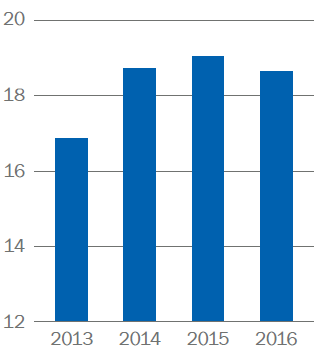
Accounting Support Fees
($ millions)
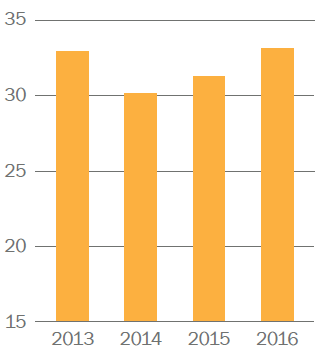
Headcount
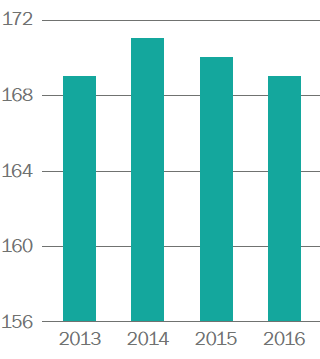
Management's Discussion and Analysis
2016 Summary
The mission of the Financial Accounting Foundation (FAF) and its standard-setting Boards, the Financial Accounting Standards Board (FASB) and the Governmental Accounting Standards Board (GASB), is to establish and improve standards of financial accounting and reporting for public and private companies, not-for-profit organizations, and state and local governments. Collectively, these standards are known as Generally Accepted Accounting Principles (GAAP). Financial accounting and reporting standards help foster and protect investor confidence, facilitate the efficient operation of capital markets, and enable citizens to assess the stewardship of public resources by their state and local governments. The FAF, the FASB, and the GASB are committed to the development of high-quality financial accounting and reporting standards through an independent and open process that results in useful financial information, considers all stakeholder views, and ensures public accountability.
The FAF is responsible for the oversight, administration, financing, and appointment of the FASB and the GASB, and their respective advisory councils, the Financial Accounting Standards Advisory Council (FASAC), and the Governmental Accounting Standards Advisory Council (GASAC). The FAF obtains its funding from three sources:
- Accounting support fees that finance FASB operating and capital expenses pursuant to Section 109 of the Sarbanes-Oxley Act of 2002 (Sarbanes-Oxley Act);
- Accounting support fees that finance GASB operating and capital expenses pursuant to Section 978 of the Dodd-Frank Wall Street Reform and Consumer Protection Act of 2010 (Dodd-Frank Act); and
- Sales and licensing of copyrighted FASB and GASB materials.
The FAF’s net assets decreased by $4.9 million in 2016 as total program and support expenses exceeded total net operating revenues by $5.9 million. Program and support expenses are funded by accounting support fees and by a portion of Reserve Funds, as described more fully in the Statements of Financial Position Reserve Fund Investments section below. In 2016, the FAF was able to significantly reduce accounting support fees with amounts made available from Reserve Fund balances. Since a portion of the funding came from Reserve Funds (which are not operating revenues) it resulted in the difference between net operating revenues and total program and support expenses. This difference was anticipated during preparation of the 2016 budget.
The FAF’s expenses include program expenses, which are those directly related to its sole program of standard setting, and support expenses, which are those related to the general administration and operation of standard-setting activities.
The 2016 program expenses related to the FAF’s primary mission of improving financial accounting and reporting standards. These efforts included fostering improvement and increased comparability of international accounting standards, working with the Private Company Council (PCC) to improve the standard-setting process for private companies, and continuing the development of the GAAP Financial Reporting Taxonomy (Taxonomy) for eXtensible Business Reporting Language (XBRL). It also includes the evaluation of the effectiveness of the standard-setting process through the Post-Implementation Review (PIR) process.
Program and support expenses increased by $2.1 million, or approximately 4%, from 2015 to 2016. The increase in program and support expenses primarily relates to the ongoing IT Enhancement project. In 2015, the FAF completed a comprehensive assessment of our use of technology and identification of new processes and systems to meet the current and future technology needs of the FAF, the FASB, and the GASB. As a result of this process, a long-term IT enhancement plan and roadmap were developed. In 2016 and 2015, program and support costs included $2.1 million and $300,000, respectively, related to the IT Enhancement project, reflecting the following initiatives:
- The development and implementation of an enterprise content management system;
- Initial development of a customer relationship management system; and
- IT governance and IT infrastructure upgrades.
Financial Results
The FAF’s financial statements are presented in accordance with GAAP and reflect the specific reporting requirements of not-for-profit organizations. The following is a discussion of the highlights of the activities and financial position of the FAF as presented in the accompanying audited financial statements.
Statements of Activities
The following charts display the sources of revenues and the program and support expenses for 2016 and 2015:
2016 Sources of Revenues
- 53%FASB Accounting Support Fees
- 18%GASB Accounting Support Fees
- 29%Net Subscriptions & Publications
2015 Sources of Revenues
- 54%FASB Accounting Support Fees
- 16%GASB Accounting Support Fees
- 30%Net Subscriptions & Publications
2016 Expenses
- 78%Program — Standard Setting
- 22%Support
2015 Expenses
- 78%Program — Standard Setting
- 22%Support
FASB Accounting Support Fees
FASB accounting support fees are assessed upon issuers, as defined by the Sarbanes-Oxley Act, to fund the expenses and other cash requirements of the FASB’s standard-setting activities, as reflected in the FAF’s annual operating and capital budget—the FASB recoverable expenses.
Equity issuers and investment company issuers are assessed a share of the accounting support fees based upon their relative average monthly market capitalization, subject to minimum capitalization thresholds. The FAF has retained the Public Company Accounting Oversight Board (PCAOB) as its agent for invoicing and collecting FASB accounting support fees. FASB accounting support fees were $24.8 million in 2016 and $23.9 million in 2015. The FAF paid the PCAOB approximately $209,000 per year for collection services in 2016 and 2015.
The Office of Management and Budget (OMB) has determined that the FASB accounting support fee is subject to sequestration pursuant to the Budget Control Act of 2011 (BCA). Sequestration amounts are based on the federal government’s fiscal year, which, for the 2016 sequestration, began on October 1, 2015, and ended on September 30, 2016. During 2016, the FAF sequestered approximately $1.77 million with respect to the FASB accounting support fee. The OMB notified the FAF that the 2016 sequestered funds were available for spending for the 2016 federal fiscal year, which began October 1, 2016. The FAF understands that the FASB accounting support fee for federal fiscal year 2017 will be subject to sequestration in a similar manner.
GASB Accounting Support Fees
Pursuant to the Dodd-Frank Act, in 2012, the SEC issued an order approving a proposed rule change to the by-laws of the Financial Industry Regulatory Authority (FINRA) to establish an accounting support fee to fund the annual budget of the GASB, including rules and procedures to provide for the equitable allocation, assessment, and collection of the GASB accounting support fee from FINRA members. FINRA collects the GASB accounting support fee quarterly from member firms that report trades to the Municipal Securities Rulemaking Board (MSRB). Each member firm’s assessment is based on the member firm’s portion of the total par value of municipal securities transactions reported by FINRA member firms to the MSRB during the previous quarter. GASB accounting support fees were $8.3 million in 2016 and $7.4 million in 2015. The increase in GASB accounting support fees reflects an increase in GASB budgeted recoverable expenses for 2016. The FAF paid FINRA $30,000 per year for collection services in 2016 and 2015.
Subscriptions and Publications
Subscriptions and publications revenue for FASB and GASB product offerings are presented in the statements of activities on a combined basis, net of direct costs of $3.7 million and $4.3 million in 2016 and 2015, respectively. Gross revenues for FASB and GASB product offerings are separately displayed in the charts below for 2016 and 2015.
FASB Subscriptions and Publications (dollars in thousands)
2016
- $13,06485%License Fees
- $2,06313%Subscription Plans
- $2442%Codification Bound Volumes
- $240%Other
- $15,395100%Total
2015
- $13,28284%License Fees
- $2,15914%Subscription Plans
- $3672%Codification Bound Volumes
- $220%Other
- $15,830100%Total
The FAF licenses the content of the FASB Accounting Standards Codification® (FASB Codification) to commercial publishers and others for inclusion in their proprietary, comprehensive, online research systems. The FASB Codification also is directly accessible through an online platform and can be viewed either through a free Basic View or as an annual paid subscription to the Professional View that provides advanced functionality and navigation. The FAF also sells a bound edition of the FASB Codification and provides The FASB Subscription, an annual paid service that includes the distribution of printed copies of FASB Accounting Standards Updates (ASUs) when issued.
FASB subscriptions and publications revenues totaled $15.4 million in 2016, down 3% from 2015. License fees were down 2% from 2015 and represented 85% of the total subscription and publication revenues in 2016.
GASB Subscriptions and Publications (dollars in thousands)
2016
- $1,13367%License Fees
- $46728%Subscription Plans
- $594%Bound Editions
- $251%Final Documents & Other
- $1,684100%Total
2015
- $1,09366%License Fees
- $50330%Subscription Plans
- $422%Bound Editions
- $272%Final Documents & Other
- $1,665100%Total
The FAF licenses GASB materials to commercial publishers and others for inclusion in their proprietary, comprehensive, online research systems. GASB materials are also directly accessible online through the Governmental Accounting Research System (GARS). GARS Online can be viewed either through a free Basic View or as an annual paid subscription to the Professional View that provides advanced functionality and navigation. GASB materials also are available through various subscription plans sold directly by the FAF, including The GASB Subscription (consisting of final documents as issued) and the GASB Board Packages. In addition, the FAF sells bound editions of the GASB Codification, GASB Original Pronouncements, and the GASB Comprehensive Implementation Guide, as well as hard copies of individual Pronouncements, User Guides, Research Reports, and other documents. GASB subscription and publication revenues totaled $1.68 million in 2016, a 1% increase from the 2015 revenues of $1.67 million. License fees increased by 4% from 2015 and represented 67% of the total subscription and publication activity in 2016.
Program Expenses
The FAF’s program expenses, which comprise the standard-setting activities of the FASB and the GASB, totaled $41.1 million in 2016, a 5% increase compared to $39.2 million in 2015. Salaries and benefits increased by $866,000, or 3%, primarily due to annual salary rate increases. Salaries and employee benefits comprise approximately 81% of the FAF’s program expenses. Professional fees increased by $1.3 million primarily related to the IT Enhancement project, which directly supports the standard-setting activities of the FASB and the GASB. Other program expenses include domestic and international travel for the FASB and the GASB Board members and staff, costs for holding advisory group and other meetings, library subscriptions and other reference materials, and other miscellaneous expenses.
Support Expenses
The FAF’s support expenses totaled $11.5 million in 2016, compared to $11.3 million in 2015. The increase was largely due to a 5% increase in salaries and employee benefits costs primarily due to annual salary rate increases.
Pension-Related Changes Not Reflected in Operating Expenses
Pension-related changes are nonoperating adjustments to record the change in the funded status of the Employees’ Pension Plan and the postretirement health coverage plan (Postretirement Plan). Pension-related changes are determined by comparing the fair value of plan assets against the actuarially determined amount of benefit obligations. The FAF recorded a nonoperating increase in net assets of $81,000 and $554,000 for 2016 and 2015, respectively. The valuation of the benefit obligation is highly sensitive to changes in the discount rate. The decrease in the discount rate in 2016, after an increase in 2015, increased the benefit obligation for all the plans. However, other items positively impacted the valuations in 2016, including a change in the mortality rate assumptions and increase in the fair value of the plan assets.
Statements of Financial Position
Reserve Fund Investments
The FAF established the Reserve Fund to: (1) provide the FAF, the FASB, and the GASB with sufficient reserves to fund expenditures not funded by accounting support fees or subscriptions and publications revenues; (2) fund the operations of the FAF, the FASB, and the GASB during any temporary or permanent funding transition periods; and (3) fund unforeseen contingencies.
If the projected year-end Reserve Fund balance, which is net of short-term investments, exceeds the year-end target Reserve Fund, the FAF has historically voluntarily contributed this amount to fund the FASB and the GASB recoverable expenses that would otherwise be funded by accounting support fees. Prior to 2014, the FAF’s policy was to maintain a target Reserve Fund balance equal to one year of budgeted gross expenses for the entire organization plus a working capital reserve equal to one quarter of net operating expenses for the entire organization. In 2014, the Trustees approved a change to the FAF’s cash management policy to cap the targeted year-end Reserve Fund at one year of budgeted operating expenses (eliminating the working capital reserve of one quarter of net operating expenses). This change was phased in over a three-year period beginning in 2014. The change in policy reflects, among other things, improved working capital cash flow resulting from the quarterly billing of GASB accounting support fees.
Accounting support fee assessments in 2016 and 2015 were offset by the amounts made available from Reserve Funds of $18.6 million and $19.0 million, respectively. These amounts have benefited from favorable variances in revenues and expenses between budget and actual that carry over from the prior year and other items that affect the balance of the Reserve Fund, including the effect of the change in the FAF’s cash management policy to reduce the required amount of the targeted Reserve Fund.
Reserve Fund investments are unrestricted assets of the FAF and totaled $58.9 million and $62.4 million as of December 31, 2016 and 2015, respectively. The Reserve Fund’s assets were invested in approximately equal proportions in a money market mutual fund and a short-term, high-credit quality, fixed income mutual fund.
Accounting Support Fees, Subscriptions and Publications, and Other Receivables
Receivables as of December 31, 2016 and 2015 included $2.9 million and $2.4 million of GASB accounting support fees and $2.9 million and $2.5 million of license fees, respectively. The remaining balance primarily related to subscriptions and publications.
Accrued Postretirement Health Care Costs
The funded status of the Postretirement Plan amounted to a $2.9 million net liability in 2016, compared to a net liability of $1.5 million in 2015. This increase was primarily driven by an increase in the benefit obligation of $1.8 million resulting from a decrease in the discount rate and benefit accruals offset by a $423,000 increase in plan assets due to investment gains.
Accrued Pension Costs
The funded status of the Employees’ Pension Plan amount to a $1.4 million net liability in 2016, compared to a net liability of $2.8 million in 2015. The decrease in the net liability of the Employees’ Pension Plan was primarily due to an increase in plan assets reflecting $1.0 million in employer contributions and investment gains.
Outlook For 2017
The FAF will continue to manage our resources prudently, while appropriately investing in technology and other initiatives in fulfilling the important mission of the FASB and the GASB. The IT Enhancement project that started in late 2015, will continue with an implementation of a constituent relationship management system, enterprise content management system enhancements, and other infrastructure upgrades. Overall, we expect headcount to decrease slightly in 2017, primarily related to a decrease in the number of temporary fellow positions, reflecting the staffing needed to support the future agendas of the Boards, particularly after the completion of several major projects. There have been proposals from Congress about potential changes to the Dodd-Frank Wall Street Reform and Consumer Protection Act of 2010, which includes provisions related to the accounting support fees that are assessed in accordance with provisions of that law and that support the standard-setting activities of the GASB. The FAF will continue to monitor closely any potential changes to such provisions and the impact that they may have on the accounting support fees for the GASB.
Statements of Activities
| For the years ended December 31 (dollars in thousands) | 2016 | 2015 |
|---|---|---|
| Net operating revenue: | ||
Accounting support fees (Note 2): |
||
FASB |
$24,782 | $23,908 |
GASB |
8,310 | 7,357 |
Total accounting support fees |
33,092 | 31,265 |
Subscriptions and publications (Note 3) |
17,079 | 17,495 |
Less: Direct costs of subscriptions and publications (Note 3) |
3,740 | 4,326 |
Net subscriptions and publications |
13,339 | 13,169 |
Contributions—FAF contributed services |
195 | 240 |
Total net operating revenue |
46,626 | 44,674 |
| Program expenses: | ||
Salaries and wages |
26,982 | 26,196 |
Employee benefits (Note 5) |
6,303 | 6,223 |
Occupancy and equipment expenses (Note 7) |
1,488 | 1,447 |
Depreciation and amortization |
393 | 465 |
Professional fees |
3,655 | 2,375 |
Other operating expenses |
2,276 | 2,484 |
Total program expenses |
41,097 | 39,190 |
| Support expenses: | ||
Salaries and wages |
4,433 | 4,117 |
Employee benefits (Note 5) |
1,424 | 1,468 |
Occupancy and equipment expenses (Note 7) |
846 | 841 |
Depreciation and amortization |
218 | 236 |
Professional fees |
3,128 | 3,070 |
Other operating expenses |
1,423 | 1,592 |
Total support expenses |
11,472 | 11,324 |
| Total program and support expenses | 52,569 | 50,514 |
| Net operating revenue less than expenses | (5,943) | (5,840) |
| Short-term investment income (Note 4) | 40 | 30 |
| Supplemental Pension Plan investment income (Note 5) | 0 | 91 |
| Reserve Fund investment income (Note 4) | 963 | 430 |
| Pension-related changes not reflected in operating expenses (Note 5) | 81 | 554 |
| Decrease in net assets | (4,859) | (4,735) |
| Net assets at beginning of year | 69,367 | 74,102 |
| Net assets at end of year | $64,508 | $69,367 |
See accompanying notes to these financial statements.
Statements of Financial Position
| For the years ended December 31 (dollars in thousands) | 2016 | 2015 |
|---|---|---|
| Current Assets: | ||
| Cash and cash equivalents | $4,049 | $6,738 |
| Short-term investments (Note 4) | 9,103 | 9,081 |
| Accounting support fee, subscription and publication, and other receivables (net of allowance for doubtful accounts of $70 and $82) |
5,821 | 5,051 |
| Prepaid expenses and all other current assets | 437 | 329 |
Total current assets |
19,410 | 21,199 |
| Noncurrent Assets: | ||
| Reserve Fund investments (Note 4) | 58,894 | 62,431 |
| Assets held in trust (Note 5) | 1,404 | 1,060 |
| Furniture, equipment, and leasehold improvements, net (Note 6) | 1,811 | 1,922 |
Total noncurrent assets |
62,109 | 65,413 |
Total assets |
$81,519 | $86,612 |
| Current Liabilities: | ||
| Accounts payable and accrued expenses | $2,128 | $2,043 |
| Accrued payroll and related benefits | 1,304 | 1,259 |
| Unearned publication and other deferred revenues | 6,309 | 6,594 |
Total current liabilities |
9,741 | 9,896 |
| Noncurrent Liabilities: | ||
| Accrued pension costs (Note 5) | 1,406 | 2,761 |
| Accrued postretirement health care costs (Note 5) | 2,860 | 1,523 |
| Accrued rent expense (Note 7) | 1,600 | 1,976 |
| Other liabilities (Note 5) | 1,404 | 1,089 |
Total noncurrent liabilities |
7,270 | 7,349 |
Total liabilities |
17,011 | 17,245 |
| Net Assets—Unrestricted | 64,508 | 69,367 |
Total liabilities and net assets |
$81,519 | $86,612 |
See accompanying notes to these financial statements.
Statements of Cash Flows
| For the years ended December 31 (dollars in thousands) | 2016 | 2015 |
|---|---|---|
| Cash flows from operating activities: | ||
Cash received from subscription and publication sales |
$16,412 | $18,567 |
Cash received from accounting support fees |
32,705 | 30,485 |
Interest and dividend income received |
756 | 766 |
Cash paid to vendors, employees, and benefit plans |
(55,480) | (55,152) |
Net cash used in operating activities |
(5,607) | (5,334) |
| Cash flows from investing activities: | ||
Proceeds from sales of Reserve Fund investments |
67,285 | 13,841 |
Purchases of Reserve Fund investments |
(63,501) | (8,978) |
Proceeds from sales of short-term investments |
8,000 | 8,000 |
Purchases of short-term investments |
(8,022) | (7,848) |
Proceeds from sales of assets held in trust |
— | 2,175 |
Purchases of assets held in trust |
(344) | (304) |
Purchases of furniture, equipment, and leasehold improvements, net |
(500) | (311) |
Net cash provided by investing activities |
2,918 | 6,575 |
Net (decrease) increase in cash and equivalents |
(2,689) | 1,241 |
Cash and equivalents at beginning of period |
6,738 | 5,497 |
Cash and equivalents at end of period |
$4,049 | $6,738 |
| Reconciliation of decrease in net assets to net cash used in operating activities: |
||
| Decrease in net assets for the period | $(4,859) | $(4,735) |
| Adjustments to reconcile decrease in net assets to net cash used in operating activities: |
||
Depreciation and amortization |
611 | 700 |
Net realized and unrealized (gains) losses on Reserve Fund investments |
(247) | 294 |
Net realized and unrealized gains on assets held in trust |
— | (78) |
Credit for recoveries on accounts receivable |
(12) | (5) |
(Increase) decrease in accounting support fee, publication and subscription, and other receivables |
(758) | 280 |
(Increase) decrease in all prepaid costs |
(108) | 54 |
Increase (decrease) in accounts payable, accrued expenses, pension and other benefit accruals |
112 | (1,779) |
Increase in other liabilities |
315 | 295 |
(Decrease) increase in unearned publication and other deferred revenues |
(285) | 16 |
Decrease in accrued rent expense |
(376) | (376) |
| Total adjustments | (748) | (599) |
| Net cash used in operating activities | $(5,607) | $(5,334) |
| Supplemental Information | ||
| Noncash items included in the Statement of Activities: | ||
Pension-related changes not reflected in operating expenses |
$81 | $554 |
See accompanying notes to these financial statements.
Notes to the Financial Statements
1. Nature of activities and summary of significant accounting policies
Activities
The Financial Accounting Foundation (FAF), incorporated in 1972, is the independent, private-sector not-for-profit, non-stock corporation with responsibility for establishing and improving financial accounting and reporting standards, through an independent and open process, and educating stakeholders about those standards. The FAF is responsible for the oversight, administration, finances, and appointment of the members of:
- The Financial Accounting Standards Board (FASB), which establishes standards of financial accounting and reporting for nongovernmental entities, and the Financial Accounting Standards Advisory Council (FASAC)
- The Governmental Accounting Standards Board (GASB), which establishes standards of financial accounting and reporting for state and local governmental entities, and the Governmental Accounting Standards Advisory Council (GASAC).
The FAF was incorporated under Delaware General Corporation Law to operate exclusively for charitable, educational, scientific, and literary purposes within the meaning of Section 501(c)(3) of the Internal Revenue Code, as amended (Code). The FAF obtains its funding from accounting support fees pursuant to Section 109 of the Sarbanes-Oxley Act of 2002, as amended (Sarbanes-Oxley Act), in support of the FASB; accounting support fees pursuant to Section 978 of the Dodd-Frank Wall Street Reform and Consumer Protection Act of 2010 (Dodd-Frank Act) in support of the GASB; and subscriptions and publications revenues.
Summary of Significant Accounting Policies
Presentation
The accompanying financial statements have been prepared in accordance with accounting principles generally accepted in the United States of America (U.S. GAAP).
The statements of activities are based on the concept that standard setting is the sole program of the FAF. These statements set forth separately, where appropriate, revenues, costs of sales, and certain program expenses of the FASB and the GASB (Standards Boards), in recognition of their distinct responsibilities as described in the FAF’s Certificate of Incorporation and By-Laws. Program expenses include salaries, benefits, and other direct operating expenses for the members and research staffs of the respective Standards Boards and Councils, as well as costs for the ongoing development of the U.S. GAAP Financial Reporting Taxonomy and the process for conducting Post-Implementation Reviews of FASB and GASB standards. Program expenses also include costs for external relations, government affairs and communications activities, and for the information research and technology related to the standard-setting activities of the FASB and the GASB. Additional services for accounting and finance, human resources, facilities management, technology and information systems, legal, and general administrative operating assistance have been reflected as support expenses in the accompanying statements of activities.
All of the net assets of the FAF are classified as unrestricted because none are subject to donor-imposed restrictions.
Use of Estimates
The preparation of financial statements requires management to formulate estimates and assumptions that may affect the reported amounts of assets and liabilities at the dates of those statements and revenues and expenses for the reporting periods. Significant estimates made by management include actuarially determined employee benefit liabilities. Actual results could differ from those estimates.
Accounting Support Fees
Accounting support fees are recognized as revenue in the year for which those accounting support fees have been assessed as prescribed by the Sarbanes-Oxley Act and Dodd-Frank Act. See Note 2 for further information regarding accounting support fees.
Contributions
The FAF reports all contributions as increases in unrestricted net assets. Many individuals contribute significant amounts of time to the activities of the FAF, the Standards Boards, and their Advisory Councils without compensation. These individuals include certain members of the FAF’s Board of Trustees and participants of the following groups: the FASAC and the GASAC, the Private Company Council, the FASB’s Emerging Issues Task Force, and various other FASB and GASB councils, committees, task forces, and working groups on technical projects. Many others participate in the Standards Boards’ processes by submitting comment letters, participating in public hearings and roundtable meetings, and taking part in field visits and field tests. Members of the Board of Trustees are eligible for compensation for their services, with each having the right to waive such compensation. The accompanying financial statements reflect the value of waived Trustee compensation, which meets the criteria for recognition as contributed services. The other services described above are not included as contributions in the accompanying financial statements because they do not meet the recognition criteria.
Subscription Plans and Electronic License Agreements
Revenues from publication sources are recognized over the life of the applicable subscription service or license period, typically one year. Costs for the production of updates and for fulfilment are charged to expense as incurred.
Cash and Cash Equivalents
For financial statement purposes, the FAF considers all highly liquid debt instruments purchased with an original maturity of three months or less to be cash equivalents. The carrying value of these investments approximates fair value due to the nature of the investments and the maturity period.
Investments
The FAF’s investments are recorded at fair value, all of which are measured using Level 1 inputs, which are defined as quoted market prices in active markets for identical investments. Purchases and sales of securities are recorded on a trade-date basis. Interest income is recorded on the accrual basis and dividends are recorded on the ex-dividend date. Net appreciation or depreciation includes gains and losses on investments bought and sold as well as held during the year.
Concentration of Credit Risk
Financial instruments that potentially are subject to concentrations of credit risk consist principally of cash and cash equivalents, short-term investments, and Reserve Fund investments. Short-term investments and Reserve Fund investments are held in various money market and fixed income mutual funds with a single high-credit-quality financial institution. The FAF has not experienced, nor does it anticipate, any credit-risk-related losses in such accounts.
Accounting Support Fees, Subscriptions and Publications, and Other Receivables
Receivables are carried at the amount billed or accrued, net of an allowance for doubtful accounts. The allowance for doubtful accounts is estimated based on management’s review of historical experience and current economic conditions.
Employee Benefit Plans
The FAF sponsors a postretirement health care plan and two defined benefit pension plans. Information with respect to the funded positions of each of the FAF’s pension and other postretirement plans at December 31, 2016 and 2015 is set forth in Note 5.
Furniture, Equipment, and Leasehold Improvements
Furniture, equipment, and leasehold improvements are reported in the statements of financial position at cost, less accumulated depreciation and amortization determined using the straight-line method. Furniture and equipment are depreciated over their estimated useful lives, ranging from 3 to 10 years. Leasehold improvements are amortized over periods not extending beyond the termination dates of the leases for office space.
Income Taxes
The FAF is a tax-exempt organization under Section 501(c)(3) of the Code. Management has reviewed tax positions for open tax years and determined that a provision for uncertain tax positions is not required.
Subsequent Events
The FAF has evaluated subsequent events through March 22, 2017, the date through which the financial statements are available to be issued, and determined that no events subsequent to year-end have occurred that require adjustment to, or disclosure in, the financial statements.
Recent Accounting Pronouncements
In May 2014, the FASB issued new authoritative guidance on revenue from contracts with customers. The guidance outlines a single comprehensive model for entities to use in accounting for revenue arising from contracts with customers and supersedes most current revenue recognition guidance, including industry-specific guidance. The new model will require revenue recognition to depict the transfer of promised goods or services to customers in an amount that reflects the consideration a company expects to receive in exchange for those goods or services. The FAF is still in the process of completing its analysis on the impact this guidance will have on the financial statements and related disclosures. This accounting standard will be applicable to the FAF for years beginning after December 15, 2018.
In February 2016, the FASB issued new authoritative guidance on leasing transactions. The guidance will require organizations that lease assets—referred to as “lessees”—to recognize on the balance sheet the assets and liabilities for the rights and obligations created by those leases. This accounting standard will be applicable to the FAF for years beginning after December 15, 2019. The FAF anticipates recording a related right-to-use asset and an offsetting liability related primarily to office space leases.
In August 2016, the FASB issued new authoritative guidance related to the not-for-profit financial reporting model. The new guidance marks the completion of the first phase of a larger project aimed at improving not-for-profit financial reporting. Under the new guidance, among other changes, net asset reporting will be streamlined and clarified. The accounting standard is effective for fiscal years beginning after December 15, 2017. The FAF does not anticipate there will be a material impact on the statement of activities or statement of financial position, but there will be additional enhanced disclosures related to expenses, liquidity, and financial flexibility.
2. Accounting support fees
The Sarbanes-Oxley Act provides for funding of FASB’s recoverable expenses through accounting support fees assessed against and collected from issuers of securities, as those issuers are defined in the Sarbanes-Oxley Act. The FASB accounting support fees are reviewed by the U.S. Securities and Exchange Commission (SEC) each year. The Dodd-Frank Act provides for funding of GASB’s recoverable expenses through an SEC order instructing the Financial Industry Regulatory Authority (FINRA) to establish, assess, and collect accounting support fees from its members.
The accounting support fees provide funding for recoverable expenses associated with the FASB and the GASB’s standard-setting activities as identified in the FAF’s operating and capital budget for each calendar year and reflect adjustments for noncash expenses and certain cash requirements not reflected in the statements of activities. Recoverable expenses do not include Trustee and oversight expenses. The FAF’s budgeted recoverable expenses for each Standards Board are statutorily eligible for funding by accounting support fees. However, on a voluntary basis, the FAF has applied any Reserve Funds in excess of a formula-based target amount to reduce what the FAF would otherwise be entitled to collect in accounting support fees.
The Office of Management and Budget (OMB) has determined that the FASB is subject to sequestration pursuant to the Budget Control Act of 2011 (BCA). Sequestration amounts are determined on the federal government’s fiscal year, which, for the 2016 sequestration, began on October 1, 2015, and ended on September 30, 2016. During 2016, the FAF sequestered $1,770,000 with respect to the FASB accounting support fee. The OMB notified the FAF that the 2016 sequestered funds were available for spending for the 2017 federal fiscal year, which began October 1, 2016. The FAF understands that the FASB accounting support fee for federal fiscal year 2017 will be subject to sequestration in a similar manner.
The FASB accounting support fees recognized and related expenses included in the statements of activities for the past two years are as follows (dollars in thousands):
| Years ended December 31 | 2016 | 2015 |
|---|---|---|
| FASB accounting support fees | $24,782 | $23,908 |
| FASB program expenses: | ||
Salaries and wages |
21,363 | 20,804 |
Employee benefits |
4,936 | 4,890 |
Occupancy and equipment expenses |
1,160 | 1,134 |
Depreciation and amortization |
325 | 380 |
Professional fees |
3,029 | 1,923 |
Other operating expenses |
1,760 | 1,880 |
Total FASB program expenses |
32,573 | 31,011 |
| FASB support expenses: | ||
Salaries and wages |
3,614 | 3,358 |
Employee benefits |
1,155 | 1,188 |
Occupancy and equipment expenses |
675 | 670 |
Depreciation and amortization |
174 | 188 |
Professional fees |
1,348 | 1,042 |
Other operating expenses |
937 | 1,068 |
Total FASB support expenses |
7,903 | 7,514 |
Total FASB program and support expenses |
40,476 | 38,525 |
| FASB accounting support fees less than FASB program and support expenses | $(15,694) | $(14,617) |
The accounting support fees recognized and related GASB expenses included in the statements of activities for the past two years are as follows (dollars in thousands):
| Years ended December 31 | 2016 | 2015 |
|---|---|---|
| GASB accounting support fees | $8,310 | $7,357 |
| GASB program expenses: | ||
Salaries and wages |
5,619 | 5,392 |
Employee benefits |
1,367 | 1,333 |
Occupancy and equipment expenses |
328 | 313 |
Depreciation and amortization |
68 | 85 |
Professional fees |
626 | 452 |
Other operating expenses |
516 | 604 |
Total GASB program expenses |
8,524 | 8,179 |
| GASB support expenses: | ||
Salaries and wages |
819 | 759 |
Employee benefits |
269 | 280 |
Occupancy and equipment expenses |
171 | 171 |
Depreciation and amortization |
44 | 48 |
Professional fees |
342 | 263 |
Other operating expenses |
236 | 272 |
Total GASB support expenses |
1,881 | 1,793 |
Total GASB program and support expenses |
10,405 | 9,972 |
| GASB accounting support fees less than GASB program and support expenses |
$(2,095) | $(2,615) |
The FASB and the GASB expenses include their allocable share of FAF program and support expenses. The FAF expenses are incurred for the common benefits of the FASB and the GASB.
Any differences (deficit or excess) between the accounting support fees recognized as revenues and the amount of program and support expenses (adjusted for noncash expenses and certain cash requirements), recognized for an applicable calendar year (to the extent that the deficit was not financed from Reserve Fund balances), would be applied to the calculation of accounting support fees in subsequent years.
3. Subscriptions and publications revenues and costs
Subscriptions and publications revenues and costs consist of the following (dollars in thousands):
| Years ended December 31 | 2016 | 2015 |
|---|---|---|
| Subscriptions and publications revenues: | ||
FASB publications |
$15,395 | $15,830 |
GASB publications |
1,684 | 1,665 |
| $17,079 | $17,495 |
| Direct costs: | ||
FASB publications |
$1,520 | $1,648 |
GASB publications |
219 | 112 |
FAF publication support |
2,001 | 2,566 |
| $3,740 | $4,326 |
| Net subscriptions and publications revenues: | ||
FASB publications |
$13,875 | $14,182 |
GASB publications |
1,465 | 1,553 |
FAF publication support |
(2,001) | (2,566) |
| $13,339 | $13,169 |
4. Investments and investment income and losses
Investments
The following table presents investments measured at fair value, all of which are measured using Level 1 inputs (dollars in thousands):
| At December 31 | 2016 | 2015 |
|---|---|---|
| Short-term: | ||
Money market mutual fund |
$9,103 | $9,081 |
| Reserve Fund: | ||
Fixed income mutual fund |
$29,644 | $31,216 |
Money market mutual fund |
29,250 | 31,215 |
| $58,894 | $62,431 |
Investment Income and Losses
(dollars in thousands):
| Years ended December 31 | 2016 | 2015 |
|---|---|---|
| Short-term: | ||
Interest and dividends |
$40 | $30 |
| Reserve Fund: | ||
Interest and dividends |
$716 | $724 |
Net realized and unrealized gains (losses) |
247 | (294) |
| Total Reserve Fund investment income | $963 | $430 |
Changes in the Reserve Fund balance for the past two years are as follows (dollars in thousands):
| Years ended December 31 | 2016 | 2015 |
|---|---|---|
| Fund balance, beginning of year | $62,431 | $67,588 |
| Transfers to operations, net | (4,500) | (5,587) |
| Investment income | 963 | 430 |
| Fund balance, end of year | $58,894 | $62,431 |
Reserve Fund assets are unrestricted and are maintained within the investment policies and guidelines for the Fund established by the Audit and Finance Committee of the Board of Trustees.
5. Employee Benefits
Employee benefits expense consists principally of employer payroll taxes, health care benefits for active and retired employees, and pension costs.
Pension Plans
The FAF sponsors a contributory defined contribution plan (the Employees’ Tax Sheltered Annuity Plan) and a defined benefit pension plan (the Employees’ Pension Plan). Effective January 1, 2008, the Employees’ Pension Plan was closed to all new hires, and benefit accruals for participating employees ended as of December 31, 2013.
The FAF also sponsored the Supplemental Executive Retirement Plan (SERP), a defined benefit plan, which was terminated effective December 31, 2013. The FAF maintained a Grantor Trust pursuant to Section 457(f) of the Code for the benefit of its SERP. Grantor Trust assets of the SERP are not included in the change in plan assets due to the nature of the assets. In accordance with the provisions of the plan, final payouts to vested participants totalling $1,921,500 occurred in March 2015, after a mandatory deferral period. The SERP Grantor Trust assets experienced investment income of $91,000 in 2015.
The FAF maintains a 457(b) deferred compensation plan to provide the ability to make tax-deferred contributions to employees whose annual base compensation exceeds the maximum compensation limit for qualified plan contributions under Code §401(a)(17). Contributions are made into a rabbi trust maintained by the FAF for each participating employee and remain assets of the FAF until distributed to the participant upon termination of their employment. The plan assets and related liabilities of $1,403,900 and $1,059,900 as of December 31, 2016 and 2015, respectively, are included as assets held in trusts and other liabilities in the statements of financial position.
Employee benefits expense arising from the defined contribution plan was $3,051,900 and $2,974,600 for 2016 and 2015, respectively. Employer contributions to the plan are based on the employee’s earnings level, with incremental increases based on the employee’s age, and vest after 1.5 years of service.
Postretirement Health Coverage Plan
The FAF sponsors a postretirement health coverage plan (Postretirement Plan) for all eligible retirees of the FAF with benefits varying based on retirement age and years of service. Effective January 1, 2014, the Postretirement Plan was amended to limit the level of benefits that will be paid to current employees and new hires. Retiree benefits are limited for new hires after December 31, 2013, to the lesser of (1) the year-end 2013 calculated benefit amounts or (2) the calculated benefits offered during the year of retirement. Employees hired before January 1, 2014, are eligible for retiree benefits limited to the lesser of (1) health plan costs at 2013 calculated benefit amounts subject to a cap on potential annual increases not to exceed five percent (5%) per year or (2) calculated benefits offered during the year of retirement. Benefits for participants who were retired as of December 31, 2013, will not be affected by these amendments. The FAF funds retiree health care benefits through a Grantor Trust.
Assumptions
The principal actuarial assumptions used to determine periodic benefit costs and year-end benefit obligations for the Employees’ Pension Plan and Postretirement Plan are as follows:
| Employees' Pension Plan |
Postretirement Plan |
|||
|---|---|---|---|---|
| 2016 | 2015 | 2016 | 2015 | |
| Net periodic expense assumptions: | ||||
Discount rate |
4.05% | 3.75% | 4.20% | 3.85% |
Expected return on plan assets |
4.60% | 4.80% | 6.20% | 6.50% |
| Benefit obligation assumptions: | ||||
Discount rate |
3.85% | 4.05% | 4.00% | 4.20% |
According to the provisions in the Postretirement Plan, benefit amounts for active participants as of December 31, 2013, have been assumed to increase 5.0% per year after 2013. No increases are assumed for active participants hired after 2013.
The expected long-term rates of return on plan assets assumptions were based upon a review of historical returns, and expectations and capabilities of future market performance.
The rate of compensation increase assumption no longer applies to the Employees’ Pension Plan due to the freezing of accruals as of December 31, 2013.
In addition to assumptions in the above table, assumed mortality is also a key assumption in determining benefit obligations. The assumed mortality rates reflect the Society of Actuaries (SOA) published mortality table. At December 31, 2016 and 2015, the assumed mortality rates were updated to reflect the updated MP-2016 and MP-2015 projection scales released by the SOA.
The following table sets forth the amounts recognized in the statements of financial position, the change in benefit obligations, the change in plan assets, funded status, and other information for the Defined Benefit Plans and Postretirement Plan (dollars in thousands):
| Defined Benefit Plans |
Postretirement Plan |
|||
|---|---|---|---|---|
| 2016 | 2015 | 2016 | 2015 | |
| Change in benefit obligations: | ||||
| Benefit obligation, beginning of year | $26,802 | $30,460 | $15,174 | $15,716 |
| Service cost | — | — | 581 | 686 |
| Interest cost | 1,032 | 1,036 | 629 | 599 |
| Actuarial losses (gains) | 57 | (1,257) | 889 | (1,558) |
| Benefits paid | (1,237) | (1,515) | (414) | (353) |
| Settlements | — | (1,922) | — | — |
| Retiree contributions | — | — | 65 | 72 |
| Medicare Part D reimbursement | — | — | 10 | 12 |
Benefit obligation, end of year |
$26,654 | $26,802 | $16,934 | $15,174 |
| Change in plan assets: | ||||
| Fair value of plan assets, beginning of year |
$24,041 | $25,299 | $13,651 | $14,127 |
| Employer contributions, net of Medicare Part D reimbursements of $10 and $12 in 2016 and 2015 |
1,000 | 1,000 | — | — |
| Retiree contributions | — | — | 65 | 72 |
| Actual investment income (losses) on plan assets |
1,444 | (743) | 772 | (195) |
| Benefits paid | (1,237) | (1,515) | (414) | (353) |
Fair value of plan assets, end of year |
25,248 | 24,041 | 14,074 | 13,651 |
| Funded status at end of year | $(1,406) | $(2,761) | $(2,860) | $(1,523) |
| Amounts recognized in financial statements: |
||||
Noncurrent liabilities |
$(1,406) | $(2,761) | $(2,860) | $(1,523) |
| $(1,406) | $(2,761) | $(2,860) | $(1,523) |
| Amounts recognized as pension-related changes not reflected as operating expenses: |
||||
Net actuarial losses (gains) |
$(324) | $694 | $952 | $(454) |
Amortization of net actuarial losses |
(420) | (386) | (519) | (637) |
Amortization of net prior service costs |
135 | 135 | 95 | 94 |
| $(609) | $443 | $528 | $(997) |
| Amounts not yet recognized as components of net periodic benefit costs: |
||||
Net actuarial losses |
$9,453 | $10,198 | $5,989 | $5,555 |
Net prior service credits |
(180) | (315) | (695) | (790) |
| $9,273 | $9,883 | $5,294 | $4,765 |
| Amounts expected to be recognized during the year ended December 31, 2017 and 2016: |
||||
Amortization of net actuarial losses |
$477 | $420 | $579 | $519 |
Amortization of net prior service credits |
(135) | (135) | (95) | (95) |
| $342 | $285 | $484 | $424 |
Plan Assets
Investment objectives and policies for the plan assets are established by the Audit and Finance Committee (Committee) of the FAF Board of Trustees. The overall long-term investment strategy for the Employees’ Pension Plan and Postretirement Plan is to generate returns sufficient to meet obligations of plan participants and their beneficiaries at acceptable levels of risk by maintaining a high standard of portfolio quality and achieving proper diversification. The Committee has retained a professional investment manager for the assets of the employee benefit plans that maintains discretion over investment decisions, within asset allocation ranges recommended by the Committee.
The asset allocation for the Employees’ Pension Plan, which is consistent with the target allocation established by the Committee, was 100 percent in fixed income investments as of December 31, 2016, and is based upon the funded status of the plan, valuation of the liability, and the returns and risks relative to the liability. The asset allocation policy for the Postretirement Plan reflects the target allocation of 50 percent in equity investments (which includes 50 percent of the equity holdings for international stocks) and 50 percent in fixed income investments.
The plan assets of the Employees’ Pension Plan and Postretirement Plan were invested in mutual funds at December 31, 2016 and 2015, the majority of which were indexed. The following table presents the fair value of major categories of plan assets, all of which are measured using Level 1 inputs, as defined (dollars in thousands):
| Employees' Pension Plan |
Postretirement Plan |
|||
|---|---|---|---|---|
| Fair Value of Plan Assets at December 31 | 2016 | 2015 | 2016 | 2015 |
| Mutual funds (all Level 1): | ||||
U.S. equity funds (a) |
$ — | $ — | $3,868 | $3,675 |
International equity index fund (b) |
— | — | 3,285 | 3,138 |
Fixed income funds (c) |
25,162 | 23,957 | 6,921 | 6,838 |
| Cash held by investment manager | 86 | 84 | — | — |
| Total | $25,248 | $24,041 | $14,074 | $13,651 |
Descriptions of Funds:
- (a) These funds invest in small-, mid-, and large-cap companies from diversified industries using a blend of growth and value strategies and index sampling.
- (b) This fund is passively managed and seeks to track the performance of international composite indexes. It has broad exposure across developed and emerging non-U.S. equity markets. Approximately 50% is invested in European companies.
- (c) These funds are passively managed using index sampling and consist of short-term, intermediate-term, long-term, and extended duration mutual funds.
Net Periodic Benefit Expense
The components of net periodic benefit expense for the past two years are as follows (dollars in thousands):
| Employees' Pension Plan |
Postretirement Plan |
|||
|---|---|---|---|---|
| 2016 | 2015 | 2016 | 2015 | |
| Service cost | $ — | $ — | $581 | $686 |
| Interest cost | $1,032 | $1,036 | $629 | $599 |
| Expected return on plan assets | (1,063) | (1,209) | (834) | (908) |
| Amortization of prior period actuarial losses |
420 | 399 | 519 | 637 |
| Amortization of prior service credits | (135) | (145) | (95) | (95) |
| Net periodic benefit expense | $254 | $81 | $800 | $919 |
The following benefit payments, which reflect expected future service, are projected to be paid under the FAF’s benefit plans, including the amounts of Medicare Part D subsidies for the Postretirement Plan (dollars in thousands):
| Postretirement Plan |
||||
|---|---|---|---|---|
| Years ended December 31 | Employees' Pension Plan | Gross | Medicare Part D | Net |
| 2017 | $2,103 | $434 | $7 | $427 |
| 2018 | 1,826 | 498 | 8 | 490 |
| 2019 | 1,761 | 559 | 10 | 549 |
| 2020 | 1,551 | 591 | 11 | 580 |
| 2021 | 1,924 | 658 | 12 | 646 |
| 2022—2026 | 8,747 | 4,255 | 89 | 4,166 |
The FAF expects to contribute $250,000 to the Employees’ Pension Plan and $750,000 to the Postretirement Plan during 2017.
6. Furniture, equipment, and leasehold improvements
(dollars in thousands)
| Years ended December 31 | 2016 | 2015 |
|---|---|---|
| Furniture and equipment | $8,216 | $8,248 |
| Leasehold improvements | 5,346 | 5,174 |
| 13,562 | 13,422 | |
| Accumulated depreciation and amortization | (11,751) | (11,500) |
| $1,811 | $1,922 |
7. Lease commitments
The FAF has an operating lease on the Norwalk office space until September 30, 2022. Total rental expense for office space and equipment amounted to $2,154,000 and $2,089,000 in 2016 and 2015, respectively. Accrued rent expense is attributable to escalating minimum lease payments, initial rent abatement, and leasehold improvement allowances. The rent expense liability is being amortized over the remaining term of the applicable operating lease.
Future minimum payments under the operating lease for office space, including the FAF’s current share of real estate taxes and other operating costs, are as follows (dollars in thousands):
| Years ended December 31 | |
|---|---|
| 2017 | $1,743 |
| 2018 | 1,841 |
| 2019 | 2,450 |
| 2020 | 2,454 |
| 2021 | 2,467 |
| Thereafter | 1,850 |
Total minimum lease payments |
$12,805 |
Management’s Report on Financial Responsibility and Internal Controls
Management of the Financial Accounting Foundation (FAF) is responsible for the preparation of the accompanying financial statements, and for the fairness and accuracy of the financial information included in this annual report. The financial statements have been prepared in accordance with accounting principles generally accepted in the United States of America. Management is also responsible for establishing and maintaining an adequate internal control structure and adequate procedures for financial reporting. The FAF maintains a system of internal controls designed to ensure the integrity, objectivity, and overall effectiveness of the accounting and financial reporting process, and to provide reasonable assurance as to the reliability of the entity’s financial statements for external purposes.
Internal control over financial reporting does have inherent limitations and may not prevent or detect all misstatements. Therefore, even those systems determined to be effective can provide only reasonable, and not absolute, assurance with respect to financial statement preparation and presentation. Also, due to changing conditions, the effectiveness of internal control over financial reporting may vary over time, and certain controls may prove to be inadequate.
Management of the FAF has assessed the effectiveness of the FAF’s internal control over financial reporting as of December 31, 2016. In conducting that assessment, which included limited procedures performed at management’s request by a third-party firm, consideration was given to criteria deemed appropriate in light of the size of the organization and scope of its activities, including relevant criteria set forth by the Committee of Sponsoring Organizations of the Treadway Commission in Internal Control—Integrated Framework (2013). Based on this assessment, we have concluded that internal control over financial reporting was effective as of December 31, 2016.

Teresa S. Polley
President and Chief Executive Officer
Financial Accounting Foundation

Mary P. Crotty
Chief Operating Officer
Financial Accounting Foundation

Peter C. Spencer
Director of Finance and Accounting
Financial Accounting Foundation
Independent Auditor’s Report
TO THE BOARD OF TRUSTEES FINANCIAL ACCOUNTING FOUNDATION NORWALK, CONNECTICUT
Report on the Financial Statements
We have audited the accompanying financial statements of the Financial Accounting Foundation, which comprise the statements of financial position as of December 31, 2016 and 2015, the related statements of activities and cash flows for the years then ended, and the related notes to the financial statements.
Management’s Responsibility for the Financial Statements
Management is responsible for the preparation and fair presentation of these financial statements in accordance with accounting principles generally accepted in the United States of America; this includes the design, implementation, and maintenance of internal control relevant to the preparation and fair presentation of financial statements that are free from material misstatement, whether due to fraud or error.
Auditor’s Responsibility
Our responsibility is to express an opinion on these financial statements based on our audits. We conducted our audits in accordance with auditing standards generally accepted in the United States of America. Those standards require that we plan and perform the audit to obtain reasonable assurance about whether the financial statements are free from material misstatement.
An audit involves performing procedures to obtain audit evidence about the amounts and disclosures in the financial statements. The procedures selected depend on the auditor’s judgment, including the assessment of the risks of material misstatement of the financial statements, whether due to fraud or error. In making those risk assessments, the auditor considers internal control relevant to the entity’s preparation and fair presentation of the financial statements in order to design audit procedures that are appropriate in the circumstances, but not for the purpose of expressing an opinion on the effectiveness of the entity’s internal control. Accordingly, we express no such opinion. An audit also includes evaluating the appropriateness of accounting policies used and the reasonableness of significant accounting estimates made by management, as well as evaluating the overall presentation of the financial statements.
We believe that the audit evidence we have obtained is sufficient and appropriate to provide a basis for our audit opinion.
Opinion
In our opinion, the financial statements referred to above present fairly, in all material respects, the financial position of the Financial Accounting Foundation as of December 31, 2016 and 2015, and the changes in its net assets and its cash flows for the years then ended in conformity with accounting principles generally accepted in the United States of America.

RSM US LLP
New Haven, Connecticut
March 22, 2017







